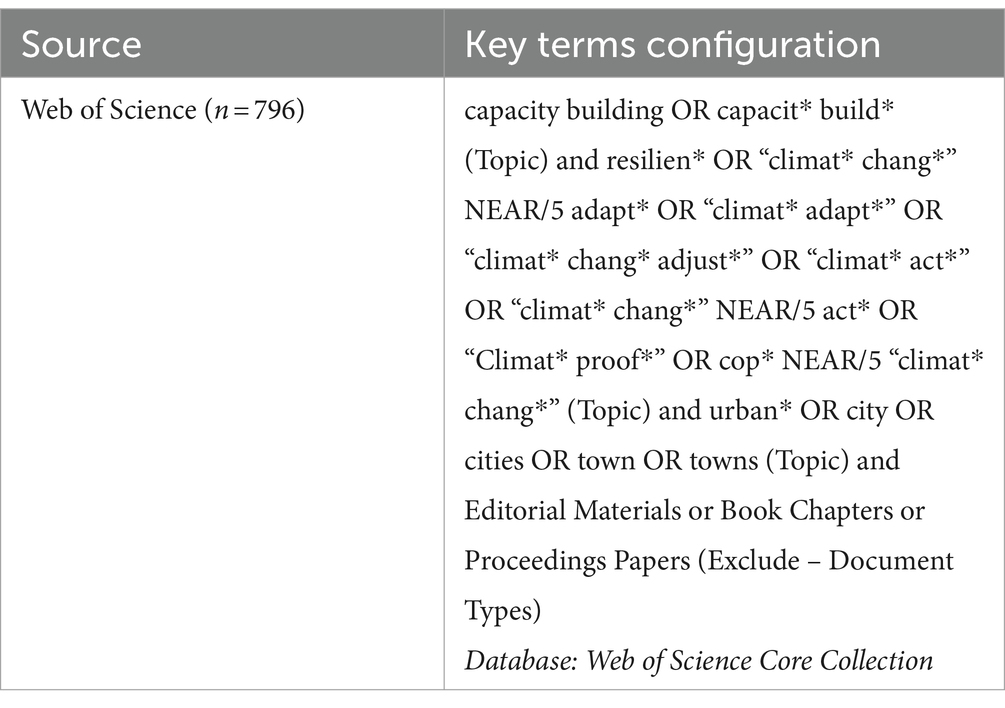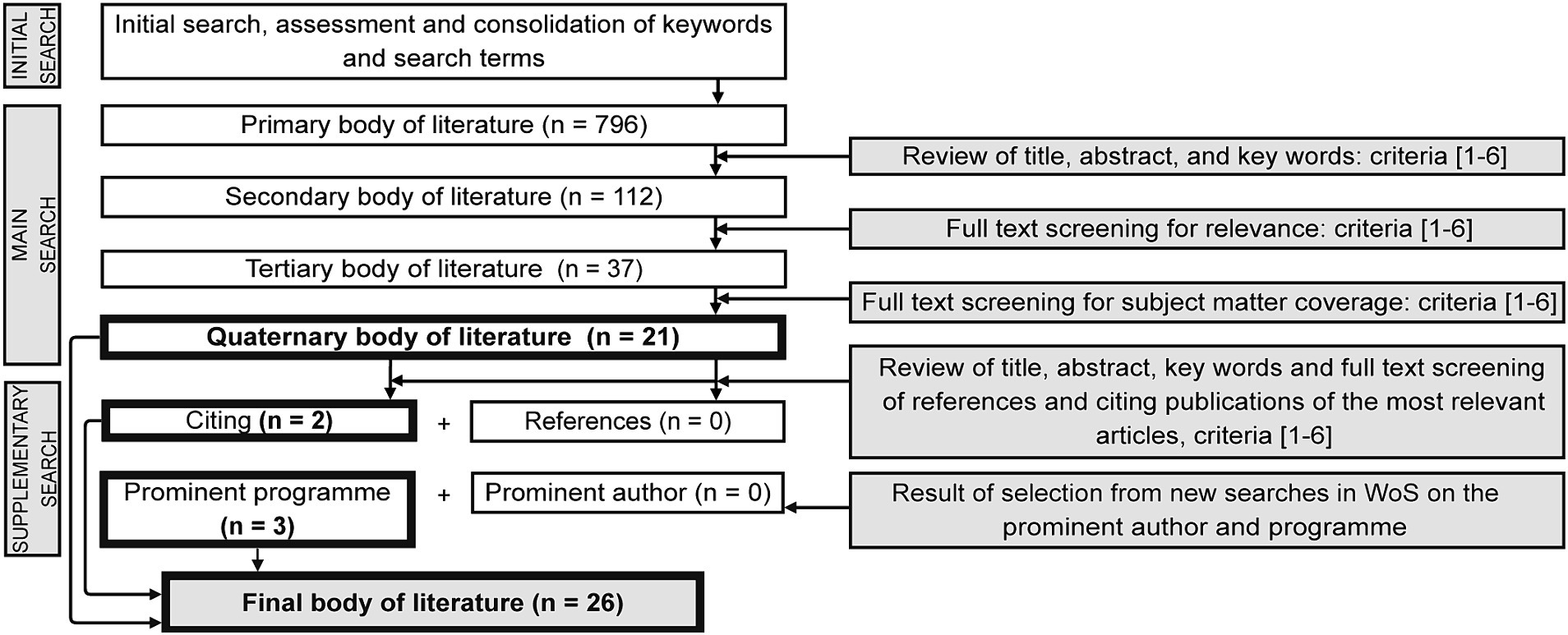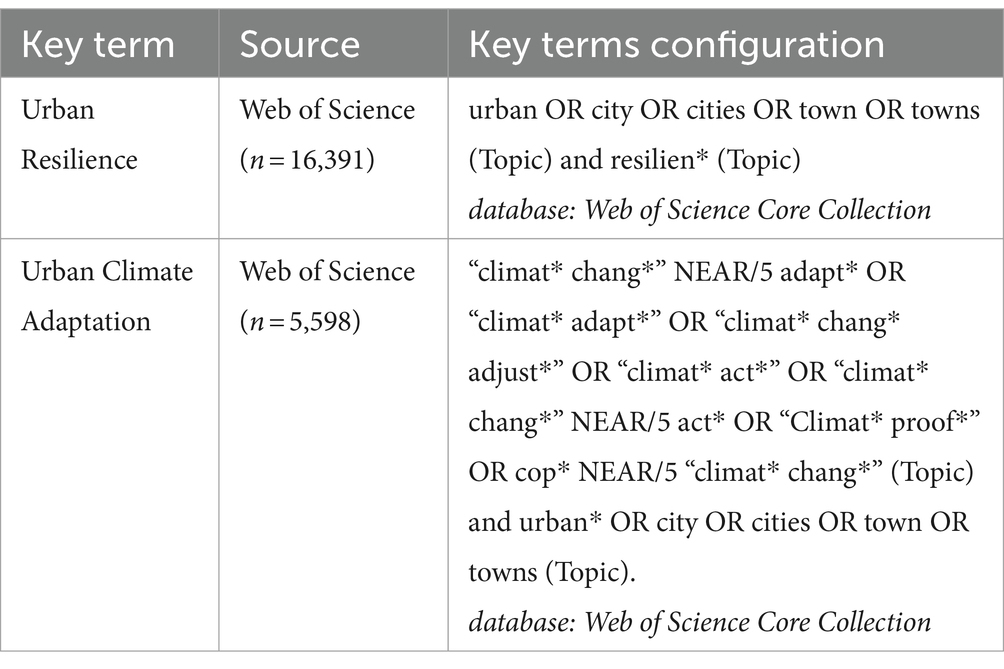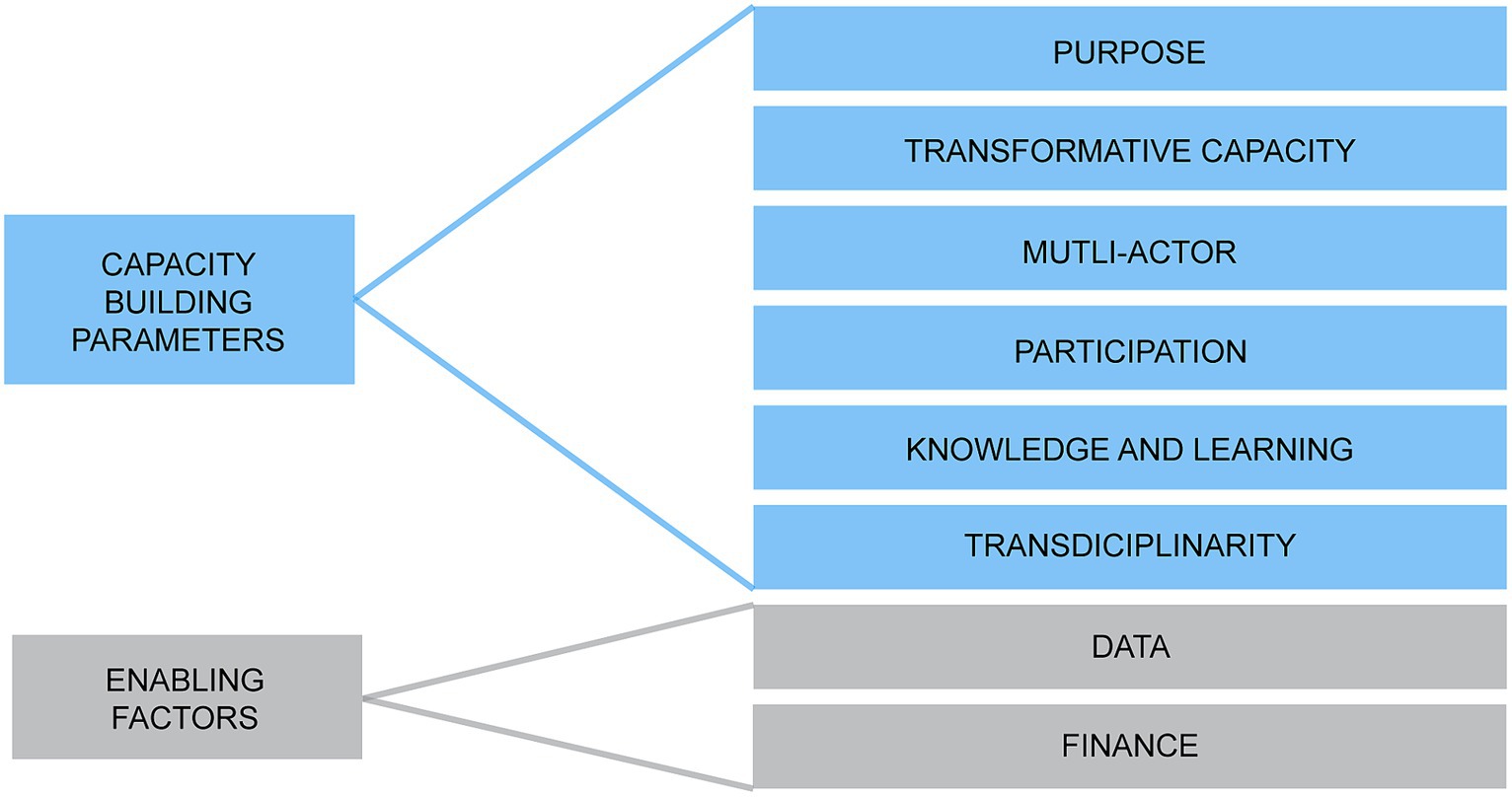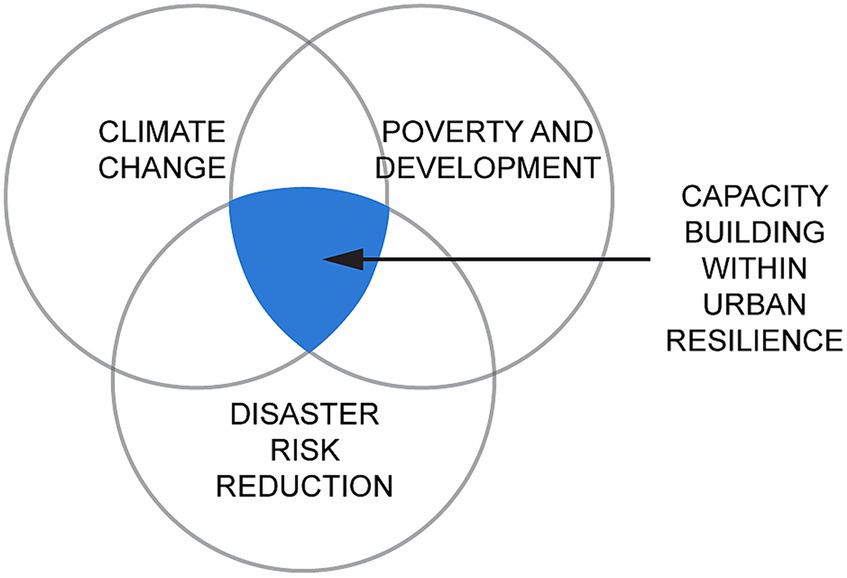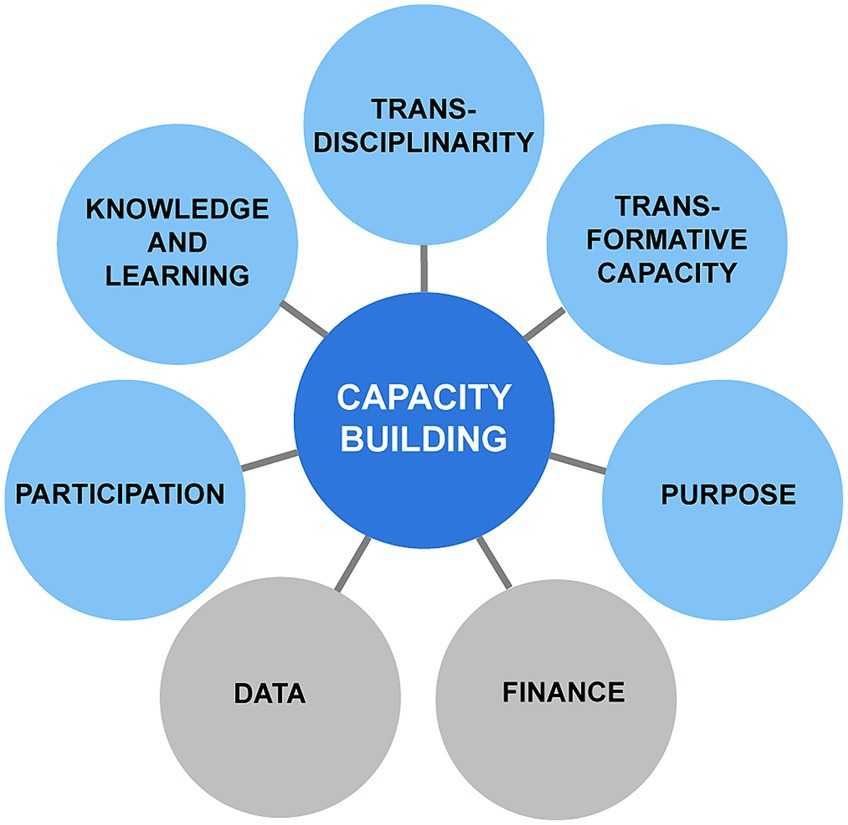- 1UNESCO Chair on Urban Resilience, Faculty of Engineering, Department of Technology and Innovation, Section for Civil and Architectural Engineering, University of Southern Denmark (SDU), Odense, Denmark
- 2Regional Representation for Africa, United Nations Human Settlements Programme (UN-Habitat), Dakar, Senegal
Capacity building for urban climate resilience is essential for strengthening both cities’ own capacities and multilevel governance, which are instrumental for the successful operationalisation of the Paris Agreement. Strengthening the capacities for planning, managing, and developing cities is required to support an urban resilient transition in a context of high complexity and uncertainty, especially in the Global South. The main objective for this article is to investigate the differences in understanding of capacity building in urban climate resilience in the Global South through literature review. Specifically, this paper investigates the main approaches, aspects, components, and end users for capacity building in the frame of urban climate resilience. The article identifies a set of Capacity Building Parameters and Enabling Factors which are Purpose, Transformative Capacity, Multi-actor, Participation, Knowledge and Learning, Transdiciplinarity as well as Data and Finance. The Capacity Building Parameters and Enabling Factors can serve as a basis to develop an analytical framework to assess existing capacity building initiatives and to support the development of new capacities for planning, management and developing cities for an urban resilient transition.
1 Introduction
Climate change is imposing significant impacts on the Global South, exacerbating existing vulnerabilities, particularly in the context of rapid urbanisation. This phenomenon and the consequential expansion of major urban centres in the Global South have coincided with the rapid emergence of highly vulnerable urban populations (Revi et al., 2014). Projections indicate that the Global South will experience the fastest urbanisation rates in the coming decades (UN, 2018), with Africa and Asia expected to contribute to 90% of the projected 2.5 billion increase in global urban population between 2018 and 2050 (Lwasa et al., 2022). Specifically, Asia is projected to account for a significant portion of global urban population growth, with over half of the world’s urban population residing in the region by 2050. Meanwhile, Africa is undergoing rapid urbanisation, with its urban population projected to triple by 2050. In contrast, urbanisation in Latin America and the Caribbean, is already high, with over 80% of the region’s population living in urban areas, and the growth rates are slowing down (UN, 2018). Moreover, cities, including those of Global South are confronted with significant threats posed by climate change, including more frequent and intense weather events such as hurricanes, droughts, cyclones, and flooding with sea-level rise resulting in negative impacts (IPCC, 2023). The effects of climate change can further exacerbate existing vulnerabilities and urban challenges and rendering it difficult to address the persistent issues, such as poverty, inequality, deficits in proper housing and others (UN-Habitat, 2020).
Therefore, capacity building emerges as a vital aspect for addressing the impacts of climate change, especially in rapidly urbanising areas, yet it poses a particular challenge, in the context of the Global South (Klinsky and Sagar, 2022), where vulnerability to those impacts is most pronounced (Bulkeley and Castán Broto, 2013). The rapid pace of urbanisation within Global South is currently surpassing existing policies, tools, means, and capacities required to manage it adequately (Spaliviero et al., 2020). This urban expansion is compounded by inadequate capacities to address climate related risks (Solecki et al., 2018). In particular, the implementation of local climate measures in these cities faces obstacles stemming from insufficient institutional, financial and technical capacities (Sharifi et al., 2017; Lwasa et al., 2022; Pillai and Narayanan, 2022) as well as a lack of political commitment (Susskind and Kim, 2022). Particularly challenged in terms of capacity building are the small and medium size cities experiencing rapid urban growth, thus are likely to be more exposed and vulnerable to climate risks (Solecki et al., 2018). These cities encounter further constraints, including limited access to technology, financial resources, and skilled human capital.
Capacity building for climate actions is becoming increasingly important within the frame of major international policies and treaties at the global level, including the United Nations Framework Convention on Climate Change (UNFCCC). The Marrakesh Ministerial Declaration in 2001 at the 7th Conference of the Parties (COP 7) of the UNFCCC launched two frameworks addressing the needs, conditions, and priorities for capacity building in developing countries and countries with economies in transition (UNFCCC, 2002). In 2011, the COP 17 launched the first Durban Forum to share experiences and good practices in building the capacity of developing countries to respond to climate change (UNFCCC, 2012). Capacity building became prominent within the global scene especially since 2015 when COP 21 adopted the Paris Agreement, specifically Article 11, stating that capacity building should increase capacities and abilities of developing countries, to take effective climate change action, facilitate technology development, and enhance aspects of education, training and public awareness (UNFCCC, 2015). COP 21 also established the Paris Committee on Capacity-Building (PCCB) (Ferraz da Silva, 2022; Nautiyal and Klinsky, 2022), which is a mechanism to address current and emerging gaps and needs, in implementing and further enhancing capacity building in developing countries, particularly those that are most vulnerable to the impacts of climate change. The PCCB facilitates the identification of capacity building needs, priorities, and gaps and aims to enhance countries capacities to implement climate actions plans and adapt to climate change effects (UNFCCC, 2016, 2017). Therefore, the PCCB plays a crucial role in helping developing countries build the necessary institutional, technical, and human capacities to meet the Paris Agreement obligations.
The term of “capacity building” was widely spread in the context of the development aid in 1950s and 1960s, undergoing interpretations and operational paradigms over successive decades. During this period, the primary objective of capacity building was directed towards eradicating poverty and fostering economic growth and development in the Global South. This endeavour encompassed various interventions such as grants-in-aid, trainings, technical assistance, alongside the privatisation of governmental services, predominantly orchestrated by actors from the Global North (Nautiyal and Klinsky, 2022). However, it became evident that merely providing financial means without added knowledge, skill, and trustworthy leadership yielded faulty outcomes. Consequently, efforts to shift towards demand-driven approaches to capacity building emerged, aiming at enhancing capabilities of local governments. Subsequent initiatives included the establishment of public-private and north–south partnerships, with the objective of bolstering institutional capacity. Nonetheless, despite these efforts, dependency on the ‘north’ competencies persisted, leading to inability to manage operations. In summary, the evolution of capacity building has been marked by inefficiency, often characterised by adoption of generic approaches that overlook the contextual factors. Throughout the 20th and 21st centuries, capacity building was mainstreamed to climate change arena, particularly in relation to local climate action and the implementation of climate projects at local level, without rethinking the practice of capacity building for the long-term solutions (Susskind and Kim, 2022).
Therefore, the concept of capacity building and the ways to operationalise it for climate change action remains unclear and ambiguous. Particularly, there is a lack of clarity and several definitions exist about what constitutes capacity building, what its underlying principles and components are, the actors involved, the successful approaches, and the type of capacities that are needed for tackling climate change at the local level effectively. In the context of the Asian Cities Climate Change Resilience Network (ACCCRN), capacity building is defined as an “improved capacity to plan, finance, coordinate and implement climate change resilience strategies” (Brown et al., 2012; Archer and Dodman, 2015). While the UNFCCC does not provide any specific definition, in more general terms, the Marrakesh Accord states that “capacity building must be country-driven, addressing the specific needs and conditions of developing countries and reflecting their national sustainable development strategies, priorities and initiatives” and that “capacity building is a continuous, progressive and iterative process, the implementation of which should be based on the priorities of developing countries” (UNFCCC, 2002). These definitions consider capacity building at different levels, either local or national.
Moreover, according to Nautiyal and Klinsky (2022), capacity building in the UNFCCC process has a two-fold approach that challenges the attempts to clearly specify its underlying goals, processes, stakeholders, and outcomes. The first, technical and technological approach for capacity building focuses on improving evaluation, data management, technology transfer and market mechanism, in mitigation context, supported by the Capacity building Initiative for Transparency (CBIT). This approach emphasizes collecting and using standardised data with generic applicability and limited contextualisation across space and time. In contrast, a second, more narrative approach, facilitated by the PCBB, attempts to embrace plural forms of knowledge, involving diverse stakeholders, and striving for a holistic and transdisciplinary approach. Furthermore, the PCBB and CBIT differs in the scope and focus. CBIT is a mechanism designed to fulfil the transparency objective, outlined in the Paris Agreement, particularly Article 13, which emphasises transparency of climate action and support. The CBIT was established to support developing countries in meeting their transparency requirements, thus outlines provisions for enhancing the transparency of climate action and support provided to ensure accountability and trust in global climate effort. Therefore, capacity building in CBIT is rather limited to the transparency mechanism of the Paris Agreement, with specific reference to institutional and technical capacities of developing countries for transparently measuring, reporting, and verifying greenhouse gas emissions and climate change actions. In contrast, the PCCB, as described earlier, is a mechanism solely dedicated to capacity building to the developing countries within the Paris Agreement (UNFCCC, 2015). These diverse formulations, understandings, approaches, and practices of capacity building call for systematisation that it is necessary to strengthen and upscale capacity building for climate action. This article will principally reference to PCBB’s transdisciplinary approach that is more aligned with its specific focus on sub-national and urban level climate action comparing to CBIT’s approach that lies principally under direct responsibility of national governments and agencies.
Cities are fundamental for the operationalisation of the Paris Agreement and the achievement of the adaptation and mitigation targets. Capacity building is essential for strengthening multi-level governance which is instrumental for the successful operationalisation of the Paris Agreement. The Nationally Determined Contributions (NDCs) often include specific requests of support for capacities at national level, but only in a limited number of NDCs there are direct request for capacity building support at urban level (Tollin et al., 2022); this signifies that there is not a lack of need, but a lack of awareness regarding the importance of capacity building at the urban level. The African NDCs generally present a stronger urban content and overall, a higher level of request for capacity building, both at the national and urban level, compared to Global South countries in Latin America and Asia. Thereby, there is a need to further assess and define the specific needs for capacity building in urban areas (Klinsky and Sagar, 2022), aware of specific challenges and size, for raising ambitions and operationalise the NDCs (Tollin et al., 2016).
Urban resilience is here understood as holistic approach integrating urban development, climate change and disaster risk reduction, in the wider frame of sustainable development, referring directly to major global policies, including Agenda 2030, New Urban Agenda, Sendai Framework for Disaster Risk Reduction and the Paris Agreement (Caldarice et al., 2018). Urban resilience is also intended as addressing socio-economic shocks and stresses of an urban system, such as poverty, unemployment, social tensions in the broader frame of development (Spaliviero et al., 2020). Cities are both exposed and vulnerable to the increasingly negative impact of climate change but, at the same time, responsible for greenhouse gas emissions driving climate change. In the face of the current global challenges, and the need to operationalise the major global agendas for climate action, there is a need for new capacities for planning, management and developing cities in a context of high complexity and uncertainty.
Therefore, the main objective for this article is to investigate the differences in understanding of capacity building within urban climate resilience in the Global South. Particularly, this paper investigates the main approaches for capacity building, its main end users, and its main components. Finally, this paper attempts to highlight which is the status of capacity building for urban climate resilience in the context of the Global South, and to highlight key knowledge gaps, proposing an analytical framework that can be used for both designing new, and assessing existing, capacity building actions in the frame of urban resilience.
2 Methodology
2.1 Search strategy: Selection of search terms, database, inclusion, and exclusion criteria
This article is a review of scientific literature (Okoli, 2015). To identify the key search terms, an initial search for peer reviewed articles in the Web of Science (WoS) was carried out by using the search terms: (capacity building) AND (climate adaptation OR resilience) AND urban. Although the operational definition of urban resilience for this article addresses both causes and effects of major global urban challenges, starting from climate change, in the literature, the word resilience is still often used as a synonym for climate adaptation. Hence, both terms were used in performing the initial and final searches. The final search query (Table 1), that was performed in June 2023 resulted in 796 scientific articles, excluding editorial materials, book chapters or proceeding papers. There were no restrictions on the publication year. The search strategy—selection of the studies for the literature review was performed in steps (Figure 1) and included several inclusion and exclusion criteria to limit the scope of the review (Table 2).
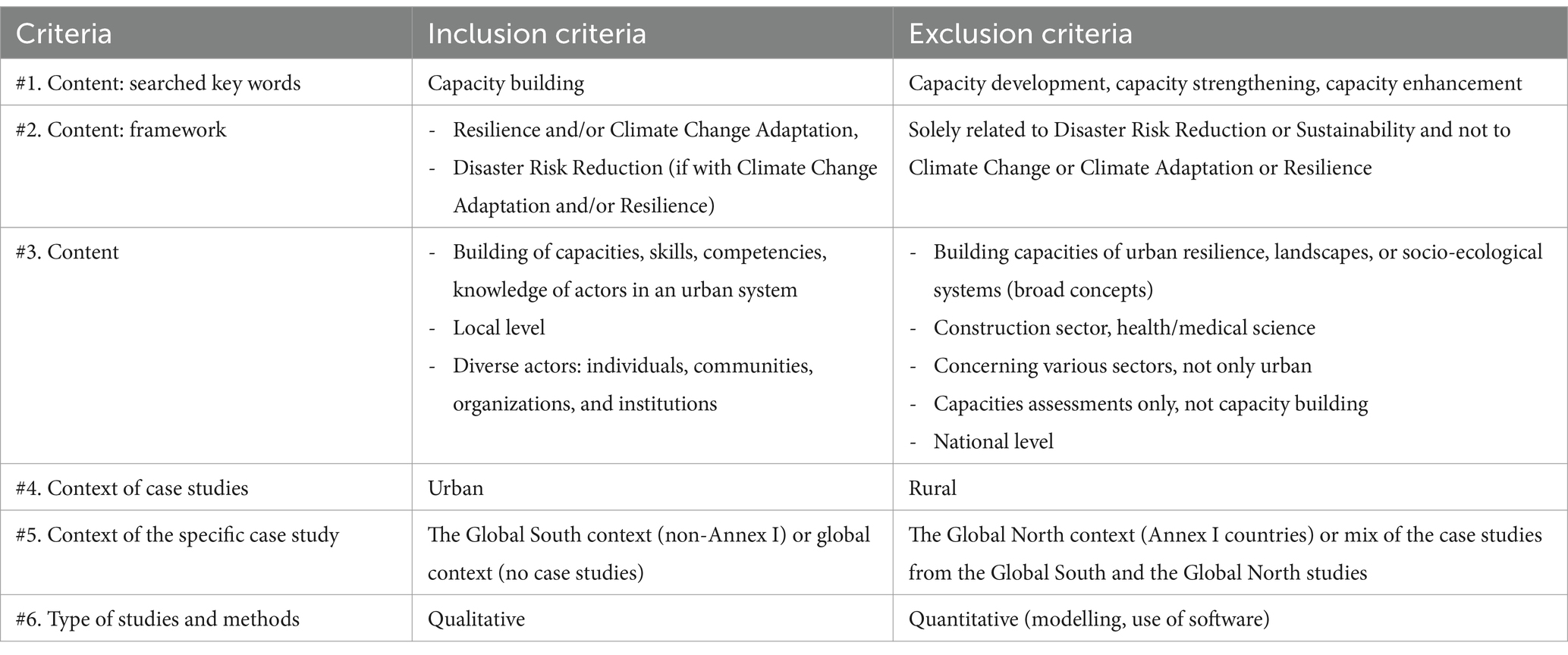
Table 2. Inclusion and exclusion thematic criteria used to select studies for the literature review.
First, topic wise the articles addressed capacity building and climate change (Table 2, #1), specifically in the articles pertinent to Resilience and Climate Adaptation (Table 2, #2). Therefore, the articles on capacity development (and synonyms as capacity strengthening or capacity enhancement) were excluded, as well as articles solely related to Disaster Risk Reduction (DRR) without climate change. Capacity development is primarily a concept mostly used in DRR and humanitarian and development aid (Hagelsteen and Becker, 2013, 2019; Susskind and Kim, 2022), which is outside of the scope of this review. Further, articles focusing on the capacity building concept were included (Table 2, #3) relating to building capacities, skills, competencies, abilities, assets, understanding and knowledge of diverse actors: individuals, communities, organizations, and institutions, on local level in relation to the urbanisation. In contrast, articles on broader concepts, multiple sectors, construction, or health sector were excluded (Table 2, #3). Finally, articles were focusing on qualitative studies (Table 2, #6) related to urban context (Table 2, #4) in the Global South, according to the classification of the UNFCCC (Table 2, #5). While most of the articles focused on the Global South, a few also addressed global context, without any specific case study pertinent to the Global South nor the Global North (Table 2, #5). These articles were included due to the importance of how these contribute to the characterization of capacity building.
The review of titles, abstracts, and keywords using the above-mentioned criteria (Table 2 from #1 to #6) allowed to select 112 out of 796 articles (Figure 1). Subsequently, screening the full texts of the articles resulted in the selection of 37 articles, and the appraisal of the articles in terms of sufficiency of relevant content resulted in the selection of 21 articles. The latter entailed a thorough review to assess whether each article contained relevant data aligned with the objectives of this literature review. More specifically, examining the depth and breadth of content was undertaken to ensure that selected articles offer comprehensive insights into the capacity building topic. The chosen articles fully or partially (chapter or paragraph) covered the capacity building topic. Therefore, the aim was to ensure the selected articles met inclusion criteria and contributed significantly to the overall understanding of the subject. In addition, the supplementary search (Okoli, 2015), referred to also as “snowballing” (Wee and Banister, 2016), was conducted to review articles not included in the final search of the WoS and with the aim of identifying other pertinent articles that either deepened the current understanding or covered new aspects of capacity building. Therefore, a process of a “backward search” (Levy and Ellis, 2006) was performed, revising the references of the particularly relevant eight articles from the primary body of 21 articles for this literature review. Furthermore, a “forward search” (Levy and Ellis, 2006) was carried out to identify articles that have since cited the most relevant eight articles. This process resulted in the selection of one article. Additionally, new searches were performed in the WoS for a prominent author, specifically Ziervogel Gina and a prominent programme, namely Asian Cities Climate Change Resilience Network (ACCCRN), which yielded 4 relevant articles. Therefore, a total of 26 studies were included in this literature review, as listed in Table 3.
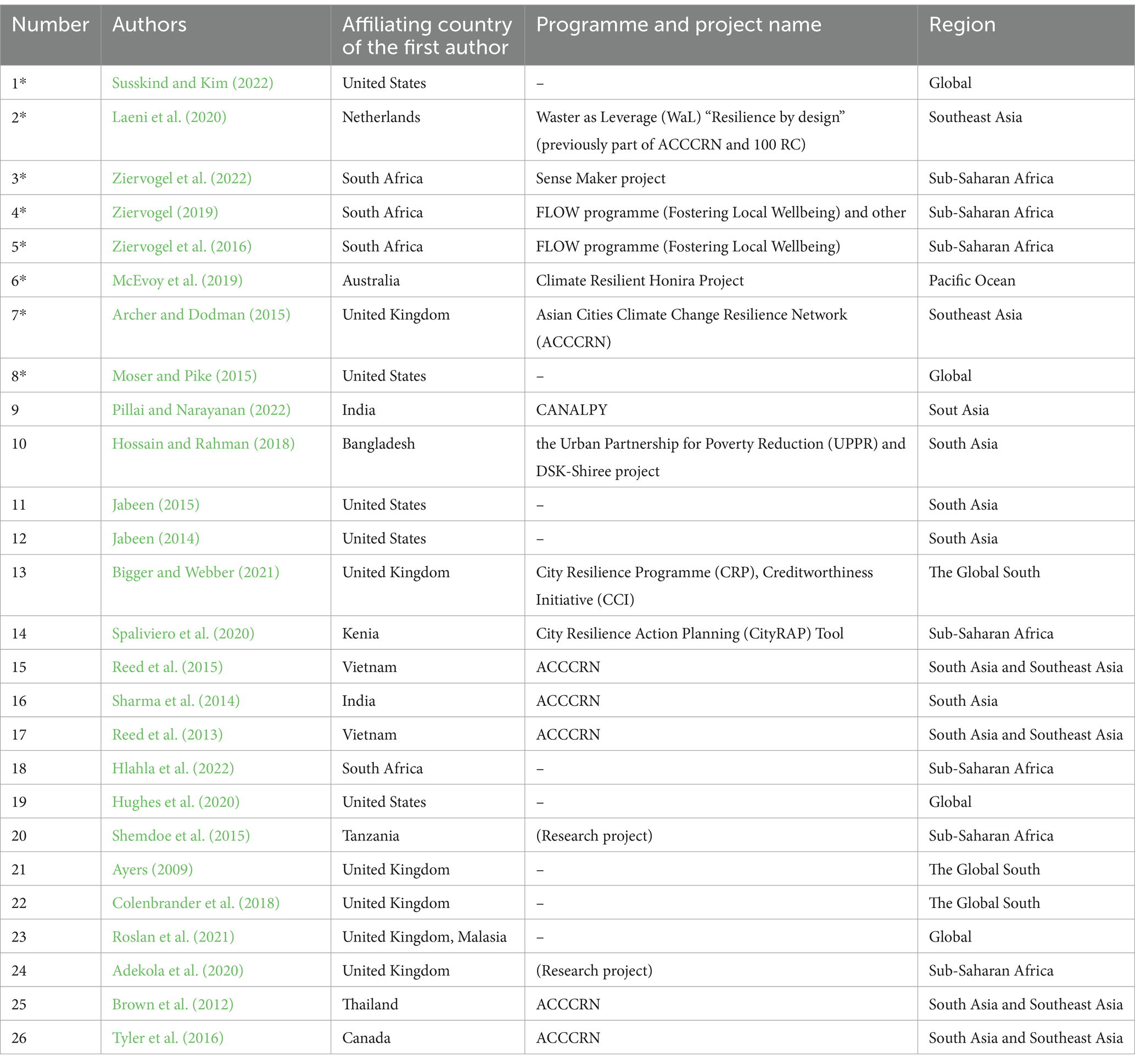
Table 3. The selection of the articles for this literature review on capacity building within urban climate resilience in the Global South (* symbolises the most relevant articles).
2.2 Data extraction and evaluation of review findings
The literature review includes a semi-quantitative analysis of the 796 articles on capacity building within urban resilience and climate adaptation resulted by the initial search (Table 1). This enabled to unpack the emerging areas in the field, especially by analysing the number of articles on urban resilience (16,391 articles), urban climate adaptation (5,598 articles) (Table 4) and capacity building (796 articles), along with the emergence of the international treaties and policy documents, such as the Paris Agreement.
Further, the review included a comprehensive qualitative analysis and synthesis of the final 26 articles (Table 3), conducted in several stages (Figure 2). Based on the review of the articles, the first stage resulted in formulating Capacity Building Categories with an Excel matrix to compile relevant data systematically. The Capacity Building Categories revealed the distinctions and commonalities in how capacity building is famed and approached. The categories determined the authors, the variety of capacity building purposes or issues they addressed, the actors targeted and involved, and the type of processes executed, among other criteria. Subsequently, the further review of the articles was undertaken to extract and analyse information based on the established criteria in the Capacity Building Categories, develop Capacity Building Thematic Trends, and expand on the understanding of Capacity Building Components.
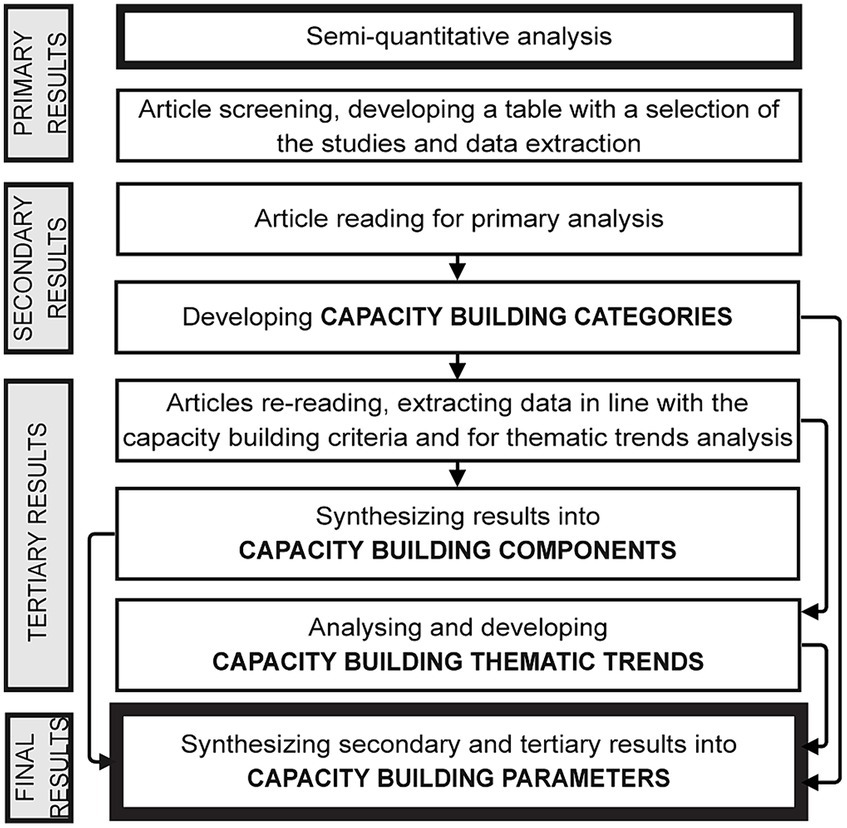
Figure 2. Data review process (analysis, extraction, and synthesis) for the literature review (source: authors).
The Capacity Building Thematic Trends were developed by a more holistic examination of the selected 26 articles, delving into the contextual evaluation of capacity building and urban resilience research programs and types of capacities. Further, the exploration of Capacity Building Components offered a more in-depth elaboration of the processes and factors outlined in the initial findings, explaining how the capacity building process can be carried out, including learning processes and knowledge generated. Ultimately, the analysis and synthesis of all preceding findings resulted in the Capacity Building Parameters and Enabling Factors. This initial framework is crucial in addressing vital questions about capacity building, covering key aspects of inquiry in this domain.
3 Results and discussion
3.1 Semi-quantitative review and case studies
In the semi-quantitative review, we examined the overall publication trends in Capacity Building (CB), Urban Resilience (UR) and Urban Climate Adaptation (UCA). As depicted in Figure 3, the study period (1975–2022) reveals three distinct phases of publication growth: an initial period, a steady growth phase, and a rapid growth phase.
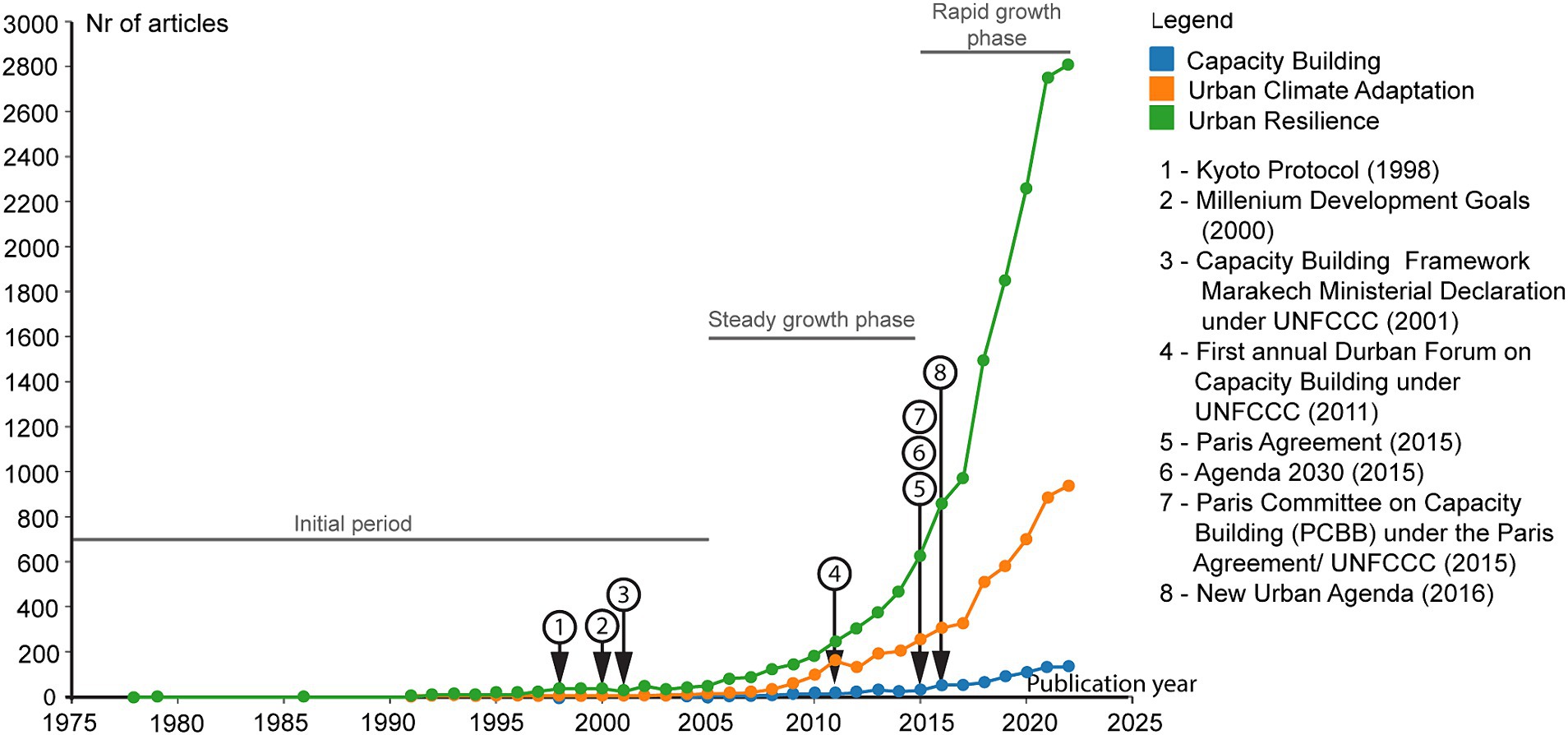
Figure 3. Trends in publications for the thematic area of Urban Resilience, Urban Climate Adaptation and Capacity Building (in UR and UCA) based on WoS data (does not include data from 2023 and 2024).
The number of articles in UR and UCA have started to be published since 1975, with a consistent growth until 2005. The articles on the CB (in UR and UCA) emerged in 1998 (Figure 4). Subsequently, during the steady growth phase from 2005 to 2015, there was a rise in articles related to UR and UCA, followed by CB (in UR and UCA). However, from 2015 to 2022 (the rapid growth phase), a significant increase in articles, particularly in UR and UCA, was evident, whereas CB (in UR and UCA) did not exhibit the same trend. In 2022, the following numbers of articles were published on the respective topics: UR had 2,809 articles, UCA had 939 articles, and CB (in UR and UCA) had 140 articles. The growth in resilience studies across diverse academic fields, along with its integration into climate change discussions, is indicative of a substantial trend (Einecker and Kirby, 2020).
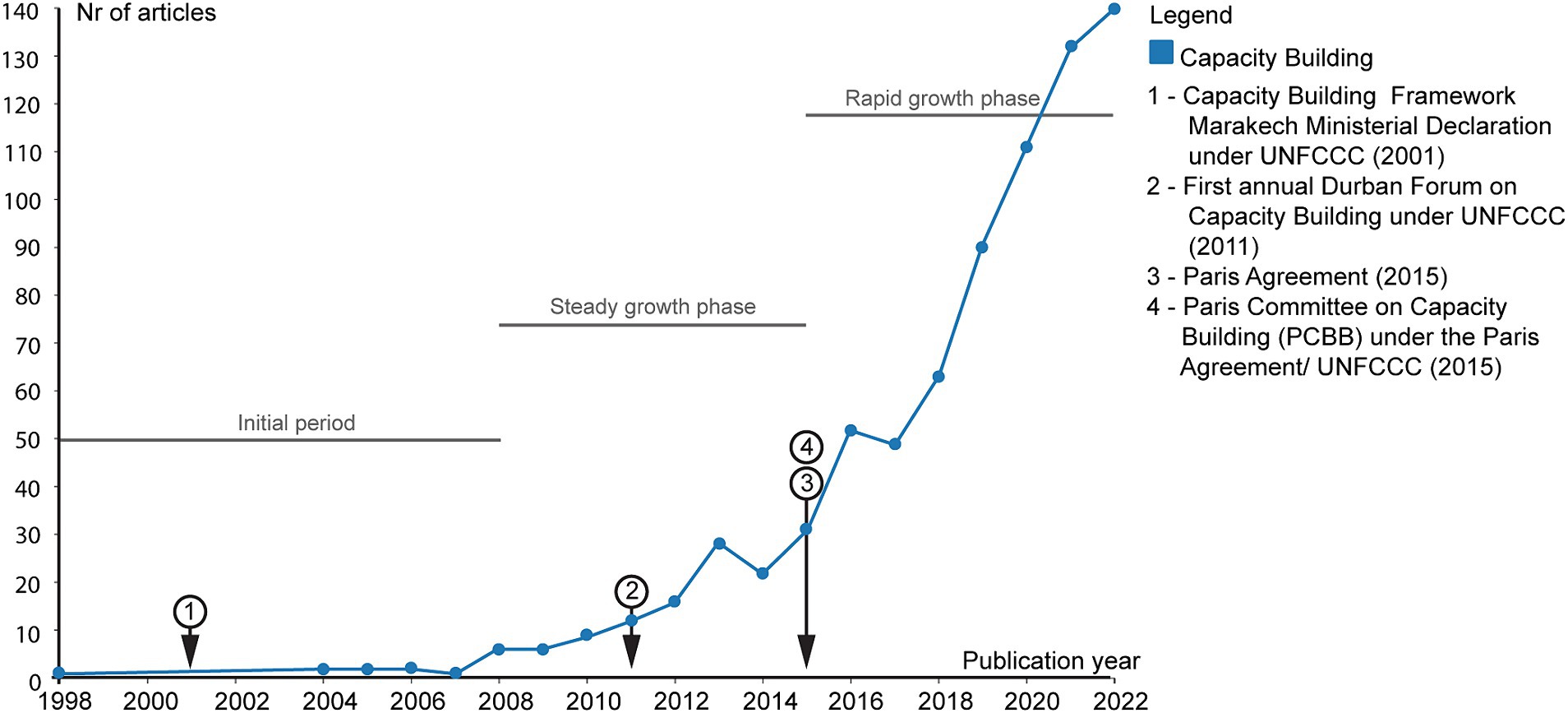
Figure 4. Trends in publications for the topic of Capacity Building in Resilience and Climate Adaptation in urban context based on the WoS data (does not include data from 2023 and 2024).
The raise of the number of articles, pertinent to UR, UCA and CB (in UR and UCA), published during the steady growth phase, between 2005 and 2015, can be explained by correlations between carried research and the emergence of policies. More specifically, the major United Nations and UNFCCC climate related agreements included policies such as the New Urban Agenda, the Agenda 2030, and the Paris Agreement.
The existing research was taken up by the policymakers to raise awareness on the institutional and political level and to prioritise the actions targeting climate change causes and impacts as well as other urban risks and setting up further priorities for the national and international research grants. Consequently, the international agendas highlighted the major global challenges, such as urbanisation and development in the frame of sustainability and climate change (which also has a multiplying effect on the impact of global challenges) (Tollin, 2017) and called for a resilient urban transition, for the operationalisation of the Paris Agreement. Although the publication trend of CB (in UR and UCA) articles from 2015 onwards was low and did not share the same type of growth as the articles in UR or UCA, it is likely to increase in the following years due to the importance of operationalisation of Paris Agreement and thus growing needs for capacity building.
The authors also revised categories of sciences to which publications were classified to determine the type of fields that consider the research on capacity building. The 796 articles were classified by the Web of Science Categories analysis (assigned at the journal level) into different science categories (with some articles classified into more than one category), then grouped by authors into eight major disciplines presented in Figure 5. It is evident that the most significant number of publications on the research subject is reported in the disciplines of Environment (655) and Earth (186), while Urban discipline is much less represented (155).
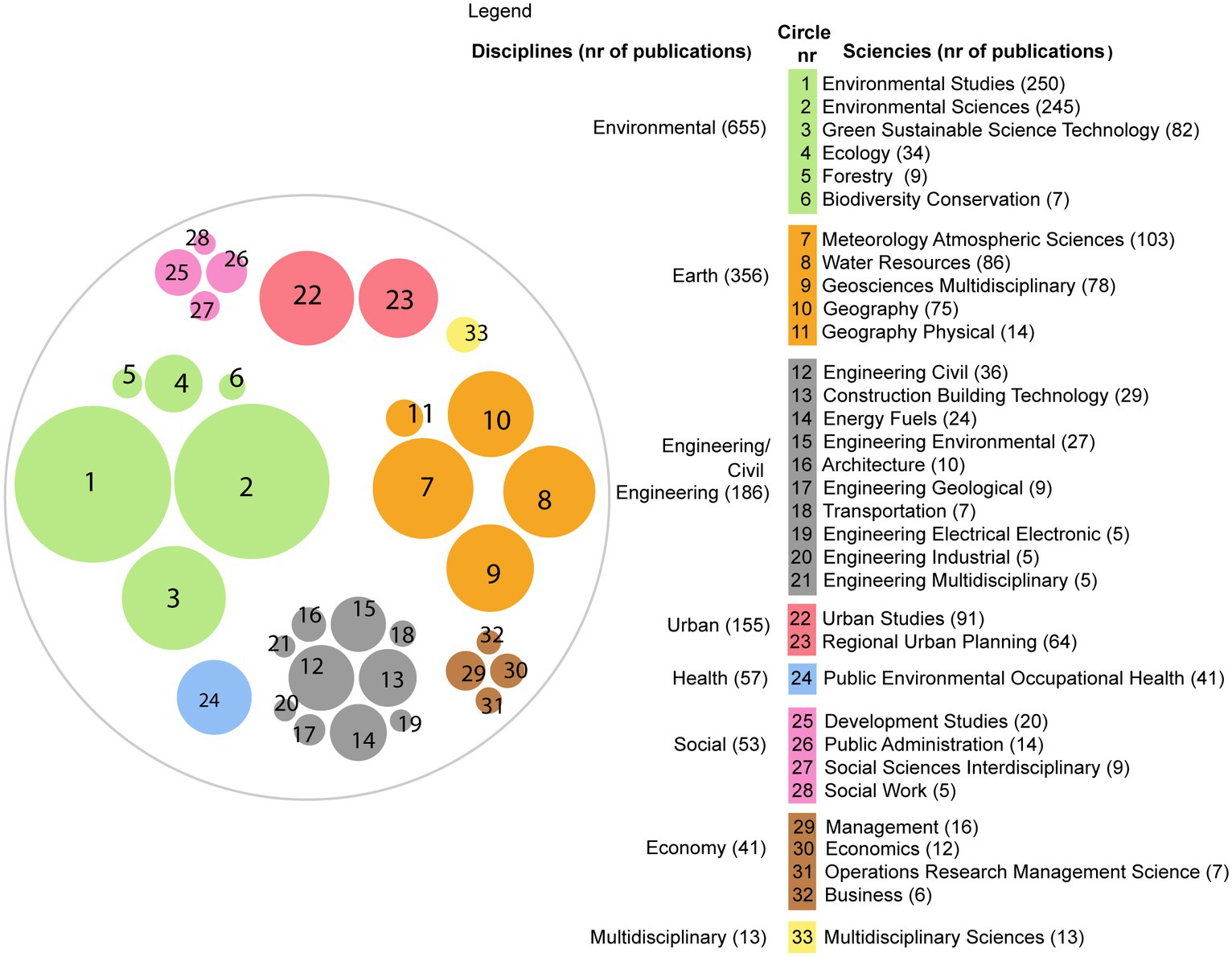
Figure 5. Major disciplines and categories of sciences based on data WoS on the topic of Capacity Building in UR and CA in urban context (does not include data from 2023 and 2024).
The literature review is based on articles encompassing both theoretical frameworks and specific case studies. In the 26 selected articles, there were 26 reported case studies (Figure 6); each being a city, a subject to research and some cities were researched more than once. Most cities (seventeen) reported in the articles are in Asia and a mostly part of the Asian Cities Climate Change Resilience Network (ACCCRN) programme, across Indonesia, Thailand, Vietnam, India, and Bangladesh. This concentration of Asian cities in research is related to the active role of ACCCRN as a specific stakeholder network in the region. Further, six case studies in Africa included South Africa, Tanzania, Nigeria, and Uganda, while only one case study was reported in Pacific, specifically in Salomon Islands. No case studies were found in Latin America, which might be attributed to several factors.
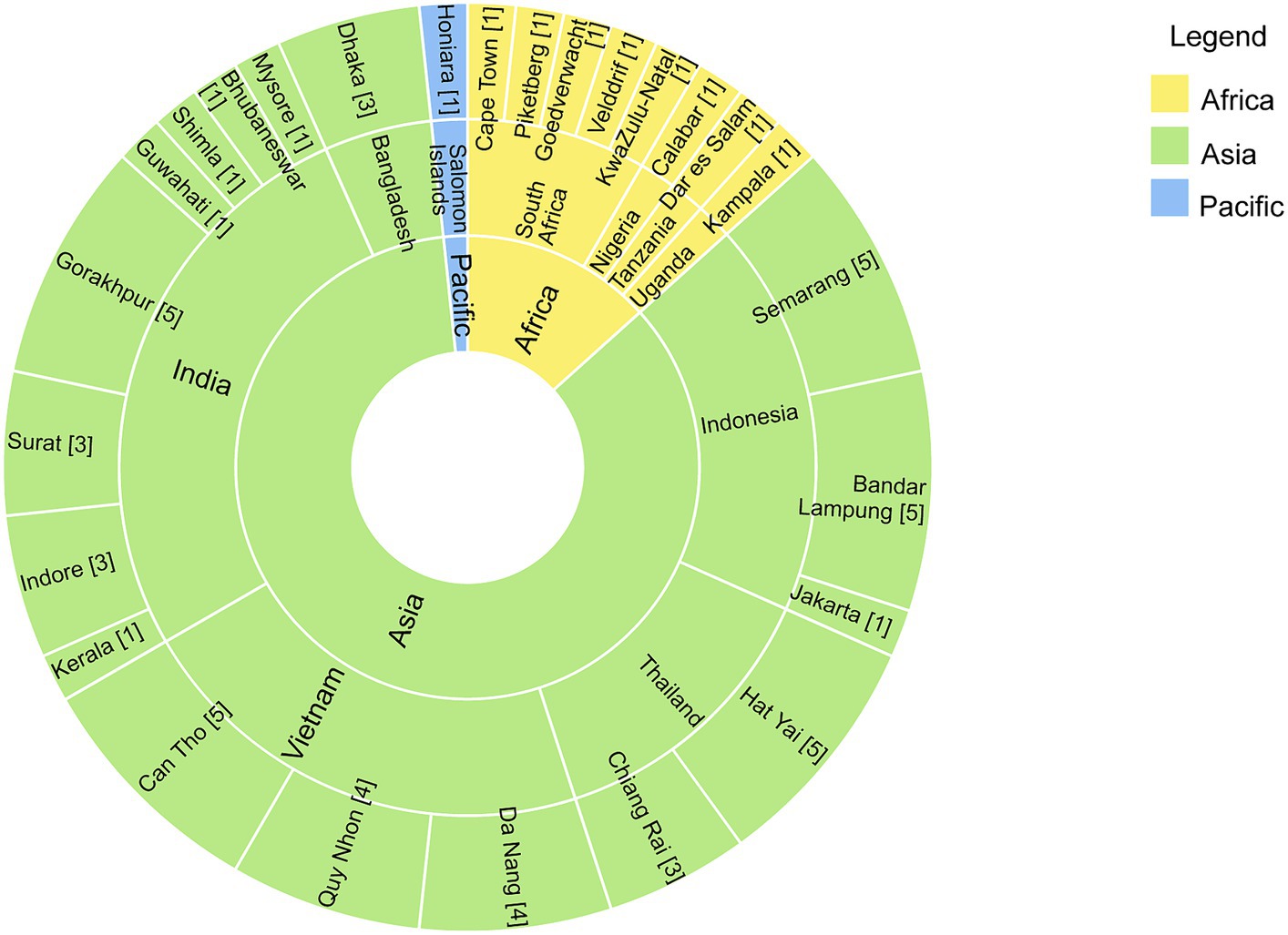
Figure 6. Reported urban case studies in the 26 articles selected for this literature review. [X] indicates number of times a case study/city has been a subject to research.
Notably, as shown in Table 3, majority of first authors of the selected articles for this literature review are from Anglo-Saxon countries, UK largely (6 authors), followed by United States of America (5), South Africa (3), Canda (1) and Australia (1). Other contributing authors are from Netherlands (1), Bangladesh (1), Kenia (1), India (2), where English is widespread with only few authors coming from other primary and secondary language, like Vietnam (2), Thailand (1) and Tanzania (1). The lack of Latin American and Caribbean authors could be related to the fact that Spanish, French and Portuguese languages are often used for scientific communication and publication in countries where these are the primary languages, in lieu of English. Furthermore, studies indicate that research on climate change has been predominantly conducted by Anglo-Saxon countries in Europe, North America, and China (Einecker and Kirby, 2020), while research on climate adaptation has been prominent in the US, UK, and Australia (Nalau and Verrall, 2021). Similarly, the leading authors with the most publications in the domain of urban resilience originate from the UK, US and the Netherlands (Guo et al., 2022).
3.2 Discussion: Capacity Building Parameters and Enabling Factors
The initial findings for developing the Capacity Building Parameters and Enabling Factors (Figure 7) are elucidated herein. First, capacity building initiatives present various purposes, aiming to foster resilience, address different urban challenges, and build specific capacities and knowledge of city actors. The scope of stakeholders targeted by capacity building initiatives is broad, including local administration, policymakers, civil society, the private sector, local NGOs and beyond. Consequently, the investigation into capacity building unfolds across different levels, spanning individual, community, and organizational. Furthermore, the fundamental process of capacity building through which it can be carried out encompasses the participation and inclusiveness of stakeholders and fostering knowledge generation. Diverse learning processes are identified, ranging from top-down approaches involving one-way knowledge transfer to collaborative, co-creative, and bottom-up processes in which decision-makers learn from the local experience.
The investigations about capacity buildings extend also to concepts of adaptive and transformative capacity. While the adaptive capacity supports individuals and communities dealing with climate impacts under the status quo, the transformative capacity is to drive change deliberately amidst conditions of complexity and uncertainty. Furthermore, inter- and transdisciplinary approaches in capacity building are noteworthy; these integrate various disciplines, thus interrelate to the learning processes and participation, and offer opportunities for experiments and innovation. It becomes evident the most impactful capacity building initiatives are inherently transdisciplinary, given the varying purposes, the issues around diverse actors and their collaborations. Capacity building emerges explicitly in inter- and transdisciplinary projects dedicated to it or within various urban resilience projects where capacity building is a component or at last, is considered an individual training project. Finally, finance and data are considered both capacity needs and gaps and enabling factors.
As expounded in the subsequent discussion sections, the Capacity Building Parameters and Enabling Factors constitute an initial framework that assists in explaining the complexities of capacity building in the Global South cities and unravelling the most pertinent questions on capacity building: Why? Who? What? How?
3.2.1 Capacity Building Parameters: Purpose
Generally, capacity building initiatives aim to respond to urban problems and challenges. The capacity building purpose can be related to different types of understanding of urban resilience as it originates from three different initial routes of resilience: poverty and development, disaster risk reduction and climate change (Figure 8). Regarding the first route, there is a need to build capacities to reduce future vulnerabilities of poor societies by targeting poverty and development issues, as depicted in Dhaka, Bangladesh (Hossain and Rahman, 2018). Concerning disaster risk reduction, it is required to undertake anticipatory and reactive actions towards hazards as documented again in Dhaka, Bangladesh (Jabeen, 2014) and govern and decrease urban risks, as experienced in the context of cities in Sub-Saharan Africa (Spaliviero et al., 2020). In connection to climate change, there is a need to build climate urban resilience (Brown et al., 2012; Archer and Dodman, 2015; Laeni et al., 2020) in conditions of complexity, uncertainty and changing context (Reed et al., 2015), as exemplified in context of various cities in Indonesia, India, Thailand and Vietnam. Therefore, capacity building is explicitly needed to respond to climate impacts (Reed et al., 2013; Moser and Pike, 2015), identify the areas of intervention (Brown et al., 2012), co-design (McEvoy et al., 2019), and develop and implement solutions (McEvoy et al., 2019; Laeni et al., 2020).
The purpose of capacity building also specifies stakeholders and their needed skills and capacities. While city leaders need to build capabilities to communicate climate issues and engage with the local communities (Moser and Pike, 2015), they need to learn how to use their knowledge, engage with powerful actors, and represent their challenges and needs, as evidenced in numerous cities of Vietnam, India, Thailand, and Indonesia (Reed et al., 2013, 2015). Further, the purpose of capacity building addresses the stages of a project cycle and policy-making. The capacity building is necessary for undertaking assessments (Adekola et al., 2020), planning (Sharma et al., 2014; Spaliviero et al., 2020) and developing strategies (Sharma et al., 2014), which was observed in Calabar, Nigeria as well as various cities in India and the region of Sub-Saharan Africa. Finally, capacity building is crucial to build competencies in streaming adaptation to the local plan and budget (Ziervogel, 2019) and experimenting with policies (Reed et al., 2015), these were observed in Piketberg, South Africa and in various cities of Thailand, Indonesia, Vietnam and India, respectively. Experimenting with policies specifies short-term objectives yet proposes various alternatives for achieving them (Susskind and Kim, 2022). However, the selected articles did not mention follow-up activities such as monitoring, evaluation, and learning. This stage is crucial as it demonstrates the effectiveness of short-term and long-term impact goals, monitors levels of change. The purpose of capacity building requires thinking beyond the project cycle stages, reframing it around issues of different societal groups, multifaceted and multiple urban challenges and employing a systems approach.
Thereby, the purpose of capacity building encompasses defining objectives and outcomes within Urban Resilience, thus addressing climate change, disaster risk reduction, poverty, and development. This also involves considering cross-cutting urban challenges and different societal groups with a systems approach.
3.2.2 Capacity Building Parameters: Transformative capacity
The distinction between adaptive and transformative capacity underscores the greater importance of transformative capacity building for fostering long-term changes in individual behaviour and enhancing the ability to address climate impacts and effects in the urban system. The type of acquired capacities affects how the scope of the urban challenges is formulated and how building resilience occurs. More specifically, adaptive capacity is the capacity to adapt to climate change, tackle communities’ vulnerabilities to address climate impacts, and other urban development challenges are assessed and dealt with, as exemplified in Dhaka, Bangladesh and in Honira, Salomon Islands (Jabeen, 2015; Hossain and Rahman, 2018; McEvoy et al., 2019; Susskind and Kim, 2022). Transformative capacity addresses the long-term effect of transformation, tackling the need to explore possible futures in the urban system under various and interconnected urban challenges, as evidenced in Piketberg, Goedverwacht and Velddrif, South Africa (Ziervogel et al., 2016; Ziervogel, 2019). Transformative capacity building goes beyond the paradigm of adaptation. Transformative capacity is the extent of individuals’ and organizations’ ability to transform themselves and their society’s actions deliberately and consciously. Therefore, it is essential to build a transformative capacity to change the current pathways (Ziervogel, 2019), break with incremental change and linear reasoning and planning.
According to Ziervogel et al. (2016) the goal of transformation is to transition towards thrivability and regenerative design in an urban system. Based on this paradigm, there are three, mutually reinforcing and fundamental factors of transformative capacity, as illustrated in South Africa. The first entails reconnection to life-support systems, where individuals unravel the essential resources for daily life and gain capacity to creatively shape their systems. Additionally, social cohesion involves strengthening connections within and beyond typical networks, fostering engaged citizenship. Finally, agency which is related to being an active citizen requires people to self-reflect and recognize their interconnectedness with others and the resources they rely on. Building on research in South Africa, Ziervogel (2019) further exemplifies how transformative capacity can be cultivated through inclusive governance, comprising three core components. First, there is a necessity to recognise experiences and challenges confronted by the urban poor in their daily lives, alongside existing governance structures and processes as an initial step to identify key areas for transformative change. Moreover, sustained intermediaries, emerging from the urban poor, can assume a pivotal leadership role in bridging stakeholders. Lastly, local governments need to adopt diverse governance approaches to engage with the urban poor more effectively. Both cases underscore the imperative for inter- and transdisciplinary collaboration in transformative capacity, to support experimentation across various levels, from local government to citizens, while remaining aware of diverse knowledge bases (Ziervogel et al., 2016, Ziervogel, 2019).
Building transformative capacity for transformative change, is a premise that refers to the urban resilience approach based on evolutionary resilience (Davoudi et al., 2012; Meerow et al., 2016; Brunetta and Caldarice, 2018). The evolutionary understanding denotes that resilience aims at a longer-term and more radical transformation. This evolutionary approach of resilience in transformative capacity building will require a systemic approach considering different components: climate change, disaster, and development. Furthermore, if individuals and civil society are to be agents of change, bounded by social cohesion as a form of collective action (Ziervogel et al., 2016), an evolutionary process requires an understanding of the current and future needs of local stakeholders. Furthermore, lasting change, or transformation require altering cultural habits and values (Davoudi, 2013; Ziervogel et al., 2016). While the potential of building transformative capacities has been recently acknowledged, it still needs to be studied and understood from an urban system perspective in practice. Since urban climate resilience is associated with complexity and multiple challenges, we need to acquire transformative capacities to deliberately direct long-term change that we aspire to as a society, which is a resilient transition in the framework of sustainable development.
Therefore, transformative capacity entails the ability of individuals and organisations to impose long-lasting systems change coupled with behavioural shifts and transformations within both organisations and societal groups. Transformative capacity can be attained by fostering prosperity and inclusive governance within an urban system.
3.2.3 Capacity Building Parameters: Multi-level multi-actor
Multiple city stakeholders involved in capacity building possess diverse knowledge and capacities and constitute greater collective potential than when dealing with a single type of stakeholder. Furthermore, the intersections of different actors can have a mutually reinforcing effect of building transformative capacities across the actors’ groups and the urban system as documented in Piketberg, Goedverwacht and Velddrif, South Africa (Ziervogel et al., 2016). This collaborative and inclusive approach for capacity building of city teams in different studies often involves local governments and policymakers, local communities, as well as the private sector, local NGOs, regional and international researchers, international experts and more. This approach was illustrated across cities in India, Indonesia, Thailand, and Vietnam, as well as in Honira, Salomon Islands and the urban context of South Africa (Sharma et al., 2014; Archer and Dodman, 2015; Reed et al., 2015; Tyler et al., 2016; Ziervogel et al., 2016; McEvoy et al., 2019; Laeni et al., 2020). In addition, some studies investigate the capacity building of local governments and communities in tandem and their interrelations (Reed et al., 2013; Ziervogel, 2019; Spaliviero et al., 2020). It is noteworthy the collaboration between local government and communities is key to better target the needs of communities to appropriately plan and develop solutions targeting climate challenges at the local level. Therefore, it is necessary to go away from the mono-actor approach for capacity building as researched in various cities across the Global South, including Dar es Salam, Tanzania (Ayers, 2009; Moser and Pike, 2015; Shemdoe et al., 2015; Hughes et al., 2020; Bigger and Webber, 2021; Susskind and Kim, 2022). The mono-actor approach hampers an effort to understand better interdependencies between various actors, and ways for collaborative approaches with mutual learning.
Furthermore, multilevel governance system is needed at the country level to manage the urbanisation and climate effort at the local level enhanced by capacity building processes. Moreover, there is a need to enhance sub-national level capacity for climate change mainstreaming for institutions to carry out effective climate risks and opportunities assessments (Fatemi et al., 2020). In terms of the local governments, they are fundamental actors responsible for managing their territory, thus being on the front line of urban climate resilience. They are also the first public reference to local communities. However, cities (local governments) are often side-lined in case of a disaster, while they should be strengthened as highlighted in, among others, in Piketberg, Goedverwacht and Velddrif, South Africa (Moser and Pike, 2015; Ziervogel et al., 2016). Moreover, local governments need to change their governance approaches to meet climate change challenges better and recognise the priorities of and include the urban poor, which is of the most fundamental requirements for building capacity (Susskind and Kim, 2022). This can be done by practising diverse modes of governance, using formal, informal, centralised, and decentralised actor networks, and supporting intermediaries as they connect different stakeholders and governance levels, exemplified, again, in the urban context of South Africa (Ziervogel, 2019). Multi-actor approach is already a recognized practice within capacity building that further needs global mainstreaming. In addition, working with the capacity building across international, national, and local levels is fundamental, as disasters and climate change cannot be targeted only on the local level but should be built by actors representing various governance levels.
Hence, a multi-actor approach to capacity building involves engaging diverse stakeholder groups that represent all the social and political domains of a city, essential for mutual learning and effectively framing and addressing challenges. Furthermore, it requires the participation of multiple governance levels to provide support and facilitate coordinated efforts, thereby enhancing the impact of actions.
3.2.4 Capacity Building Parameters: Participation
Participation and inclusiveness in capacity building relate to the capacity to establish inclusive and collaborative processes to develop mutual trust, understand shared goals and build relational networks among various actors, influencing policymaking, as demonstrated in Semarang, Indonesia (Laeni et al., 2020). Inclusiveness is necessary for the collaborative process of the cross-sectoral actors within government organizations, private sectors, NGOs, research environment, finance and others (Susskind and Kim, 2022), thus requiring a multi-actor approach in capacity building. Moreover, local governments need continuous and widespread stakeholder engagement, with actors representing all population segments. This can leverage the local knowledge in addressing priorities through participatory approaches to ensure political support and raising awareness, which constitutes necessary factors to endorse and implement proper adaptive solutions and policies. Furthermore, such a wide range of participating actors requires joint problem-solving facilitation of impartial professional mediators (Susskind and Kim, 2022) or a trusted member internal to the local community (Ziervogel, 2019). Their leadership can contribute to the vertical axis of multilevel governance by cohering with local government and other city actors, which was observed in Piketberg, South Africa (Ziervogel, 2019).
The hierarchy and power differentials give rise to questions regarding factors that may conflict with collective decision-making and the achievement of consensus. In that regard, Arnstein (2019), one of the pioneers of the participatory approaches, distinguishes different forms and gradation of citizen involvement, the Ladder of Participation. The ladder manifests who holds actual power to influence a process and decision-making, with the highest level being the degrees of civil power (Arnstein, 2019). Meanwhile, different degrees of Tokenism include symbolic participation and the powerholders having the upper hand in deciding. Nonparticipation, the lowest level, employs educating and informing the less powerful actors (Arnstein, 2019). However, the current problem with the participatory approach is not a power play holding to influence decision-making but the need for more purposeful participation. Proper and purposeful participation empowers the local communities through the involvement of their knowledge, yet currently, participation is associated with a mere exercise with the community and few local stakeholders.
Proper participation constitutes open, guided, and mediated discussion with all city stakeholders. The local, even sub-national, and national decision-makers should be part of the participatory process (i.e., the ladder of power should be represented). In this process, collective knowledge is brought up, and the consensus is gradually built. The decision-makers are part of and witness the process—that’s when trust and shared understanding are created. Finally, mutual commitments are made among the participants, publicly assuming their responsibilities (Spaliviero et al., 2011). Recent studies within climate adaptation advocate that the participants’ roles, responsibilities, and purposes should be reoriented and re-considered through a lens of collective process and not through the power dynamic. Moreover, the collective process should constitute social learning (the highest form of participation) about the issue’s attributes or a challenge and how to resolve them (Collins and Ison, 2009). In this vein, participation is the enabling condition of social learning and its precursor.
Thereby, participation in capacity building encompasses the ability to cultivate inclusive and collaborative processes among diverse groups of city stakeholders, fostering networks and shared goals and influencing policymaking. The focus is on enabling collective actions rather than on power dynamics.
3.2.5 Capacity Building Parameters: Knowledge co-production and learning
The type of knowledge used to strengthen climate resilience, disciplines and actors involved determine the decision-making and the scope of solutions. No single group has a comprehensive understanding of the issue of climate change and its resolutions (Collins and Ison, 2009). Therefore, transformative actions to adapt to climate change and transformative capacity building should rely on the process of knowledge co-creation and social learning, for which the multi-actor approach and participation are indispensable. First, knowledge co-creation provides an alternative to top-down knowledge transfer and moves away from the division of actors to the less knowledgeable and more knowledgeable facilitators, as demonstrated in Piketberg, South Africa (Ziervogel, 2019). There is a need to gain insights and expertise from various knowledge sources, arrange learning processes, and explore policy contexts and solutions, reflecting the experience of the Semarang, Indonesia (Laeni et al., 2020). Second, social learning and co-creation (Ziervogel, 2019) build a shared understanding of complex problems (Ziervogel, 2019) and vulnerabilities, which can be further integrated into planning (Laeni et al., 2020; Ziervogel et al., 2022). Third, social learning can generate long-term relations among actors and form trust by involving experiential and experts’ knowledge interacted thought collaborative processes (Pillai and Narayanan, 2022). Finally, in that sense, the capacity building engaging the local relevant knowledge of communities and knowledge systems has the potential also in tackling the issue of power imbalances (Ziervogel et al., 2022) supporting less powerful stakeholders in examining and representing their interests (Reed et al., 2013). This corresponds to transgressive approaches to learning that attempt to overstep rules, contexts, and borders, moving beyond the current restrictions to bring socially just actions, institutions, and change (Ziervogel et al., 2022).
The high complexity and interdepended climate and urban challenges, sectors, and actors require better understanding, among others, through triple loop learning (Susskind and Kim, 2022). Triple loop learning is needed for effective learning of civil society and leaders in shifting their assumptions concerning fundamental theories about climate risk sources and how best to manage them. Triple-loop learning “is required when problems are super wicked and unstructured and the deep underlying causes and context have to be taken into account in redefining, relearning, and unlearning what we have all learnt before” (Gupta, 2016). In contrast, single loop learning focuses on incremental improvements of goals and strategies. Double loop learning refers to more reflexive thinking aimed at the existing problem framing, which can bring experimentations, leading to novel measures (Laeni et al., 2020). The knowledge co-creation and social learning processes not only can ensure the self-sustaining and self-generating system of capacity building, with voices of diverse actors allowing for the long-term capacity building to be accomplished. These types of learning could address uncertainty and complexity and avoid trades-off and negative externalities when building urban resilience.
Thereby, knowledge co-production and social learning processes in capacity building involve leveraging diverse knowledge sources to establish a shared understanding of complex problems. These processes foster long-lasting relationships among stakeholders and serve as an empowering factor for marginalized groups to prioritize their interests and needs.
3.2.6 Capacity Building Parameters: Transdisciplinary approach
Transdiciplinarity approaches for capacity building encompass among others integrative, cross-disciplinary, cross-sectorial (Susskind and Kim, 2022) and collaborative processes. Transdisciplinarity refers to integrating different scientific disciplines with societal problems and diverse actors. This means that, transdiciplinarity supports uncovering or discovering the complex societal issues, often with different interests as well as supports mutual learning between science and society for joint problem-solving (Jahn et al., 2012) and novel solutions. Trans- and interdisciplinary approach in capacity building is a must to understand better the urban system, its elements and interrelations, the complexity of rapid urbanisation, and the impacts of changing climate, as exemplified in Honira, Salomon Islands (McEvoy et al., 2019). Furthermore, transdiciplainarity is fundamental to fostering knowledge co-creation, participation, empowerment, as exemplified in Cape Town, South Africa and Kerala, India (Pillai and Narayanan, 2022; Ziervogel et al., 2022), as well as building networks among actors, and more. One reason for this is that transdisciplinarity is a part of governance processes, supporting democratic and inclusive knowledge co-creation, the diversity of knowledge, and extracting the local knowledge from communities resulting in their empowerment and mutual learning (Ziervogel et al., 2022). In addition, transdisciplinary approaches together with experimentation can actively build relationships between local governments and the urban poor, as demonstrated in Semarang, Indonesia (Laeni et al., 2020), which contributes to different forms of disciplinary expertise to potential “pro-poor” interventions observed in Honira, Salomon Islands (McEvoy et al., 2019). This can inform the policy development, design, implementation (Ziervogel et al., 2016, 2022), and maintenance of urban resilience actions at multiple scales (McEvoy et al., 2019).
Transdicipalinarity, it still an open concept. To encourage new thinking and imaginaries, and derive new perspectives there are multiple ways, therefore the current conceptualisations of transdiciplinarity are not definite or exhaustive. Ziervogel et al. (2016), involving academics and practitioners in their capacity building initiative in South Africa, used a transdisciplinary approach of knowledge co-creation and participation and enriched with other agreed aspects. These included systems thinking, revealing invisible networks, actors and systems, sharing and building on successful practices, and involving all individuals with their perspectives, beliefs, experiences and capacities. Transdisciplinary approaches in capacity building are fundamental as they can move across disciplines, integrate different sectors, professions and knowledge, allowing for innovative and experimental practice, and driving radical change. Furthermore, transdisciplinary approach is vital in understanding the urban system. Given the diversity of actors and challenges, the urban system cannot be broken down or downgraded to the sum of its elements (sectors, structures, actors). Therefore, transdisciplinarity lay a solid foundation for the full participation of multi-actor and multi-level, determining and encourage knowledge co-production and social and triple-loop learning processes – thus, those are the core aspects and processes and aspects of long-term and effective capacity building supporting transformation.
Thus, transdisciplinary approach encompasses integrative, cross-disciplinary, cross-sectorial practices and aims to foster knowledge co-creation and participation and empower stakeholders. Transdisciplinarity facilitates democratic and inclusive governance processes and drives radical change in understanding and addressing the complexities of urban systems.
3.2.7 Capacity Building Enabling Factor: Finance
In the cities of the Global South, the required systems need to be implemented for sustaining urban municipal finance at the local level to strengthen the efforts to address not only the climate change challenges but all development challenges and realise resilience strategies. As Ayers (2009) observes, the official development assistance (ODA) to Global South countries has a role in funding adaptation and channelling funds through development organisations that can support building the necessary local and national institutional capacity to receive and use UNFCCC funds appropriately. However, according to Colenbrander et al. (2018) many adaptation funds managed by multilateral organisations and national governments result in a small portion of resources reaching the local level. Therefore, more multilateral climate funds should change the centralised approach, organise direct access modalities, and introduce fit-for-purpose accreditation procedures and approval processes, such as the Adaptation Fund and Green Climate Fund. Further, the national government should enhance the responsibilities of local government in the National Adaptation Plans and build their capacities, necessary resources, and data for adaptation measures. Finally, the local civil society groups should establish a collective entity, allowing them to be granted accreditation to receive and distribute funds among the members.
Furthermore, Susskind and Kim (2022) suggest that to build adaptive capacities, local governments should gain tax-raising powers, find sustainable sources of revenue, and request the finances for the adaptation measures from the state. However, local governments in Global South cities are challenged to capture private capital due to the poor governance and financial management, insufficient climate data, and the low capacity to develop bankable projects, as evidenced in Can Tho City in Vietnam, Jakarta in Indonesia and Kampala in Uganda (Bigger and Webber, 2021). Financial capital is an enabling condition for capacity building and, at the same time, one of the challenges local governments need to tackle, thus a capacity to build with the assistance of national governments. Therefore, there is a need to work on short-term and innovative long-term solutions and ensure the funds from different sources starting from the fundamental abilities of fiscal management, organising, and planning urban resilience, adapted to the needs and capacities of cities. Moreover, it is argued that financing green urban development as a transformative process can address the challenges of climate change and sustainable urbanisation in general. In this way climate change and resilience projects will not be considered distinct from urban development in general, and resilience funding can be integrated into urban planning.
Hence, finance is vital for capacity building in Global South cities, requiring reforms in multilateral climate funds for efficient funds allocation, particularly at the local level. Building capacities of local governments with the assistance of the national governments and integrating resilience funding into urban planning is essential for accessing private capital and transformative green urban development.
3.2.8 Capacity Building Enabling Factor: Data
There is a need for climate data for more comprehensive resilience planning, and at the same time, Global South cities need more financial resources to improve data collection and analysis capacities. Local governments require capacities to forecast and show the various paths for the projected future as a prerequisite to receiving funds and investing in resilience projects, especially infrastructure-related (Susskind and Kim, 2022). Further, cities require developing benchmarked data for measuring resilience to ensure private sector confidence, involvement, and public-private partnerships. For this to happen, there needs to be more access to climate and environment data, including producing, servicing, access to data management, measuring and monitoring (Bigger and Webber, 2021), which could be improved by better finances. In addition, Hughes et al. (2020) list numerous data availability challenges for data-driven climate governance. Local governments necessitate the capacity to integrate the data into the decision-making process. Therefore, researchers argue investments should be made in human and technical capacities to collect, analyse, and use the information, engage the public in the use of data, and find new sources and types of data.
Furthermore, it is imperative to include justice issues, thus considering the spatial and inequality aspect in planning using data, as decisions based on data determine whose capacity can be built. However, Spaliviero et al. (2020) challenge the idea of urban resilience planning requiring heavy data, targeting the issue of limited access to data in the Global South, especially in small and middle size cities of Sub-Saharan Africa. Instead, the authors advocate for more participatory approaches to collecting data. There is a growing awareness of contrasting challenges, on the one hand, the need for data for the projections to back up bankable projects, on the other hand, the need to continue urban resilience efforts in the face of scarce data. Consequently, there is a need to pursue innovative and low-cost practices for data collection, using the resources available, e.g., the inclusion of civil society and through crowdsourcing, as suggested for Kerala in India (Pillai and Narayanan, 2022). It is also crucial to balance the short-term solutions and long-term capacities building pertinent to data.
Thereby, access to climate data is essential for comprehensive resilience planning in Global South cities, requiring improved capacities for collection, analysis, and integration into decision-making processes. Challenges include limited data availability and advocating for participatory approaches to data collection while balancing short-term solutions and long-term capacity building.
4 Conclusion
Reviewing the selected articles in this literature review proved there is no unified and ideal framework for capacity building on the local level pertinent to urban climate resilience in the Global South. However, the rigorous process of the literature review led authors deriving Capacity Building Parameters and Enabling Factors, a framework presented in the discussion. Those are fundamental processes, approaches and concepts that constitute capacity building developing the self-sustaining, long-term impact as well as resources and enabling conditions for capacity building to take place.
It is argued that multi-actor and multilevel participation, knowledge co-creation with learning processes, and transdisciplinary approach as transversal aspects underpin the need for transformation and are fundamental core processes and aspects of capacity building, referred to Capacity Building Parameters (Figure 9). By capitalising on existing capacities and diverse knowledge sources, comprehensive capacity building can transcend disciplinary and sectorial boundaries, deriving more complex and nuanced understanding of urban and climate challenges and driving radical change. Moreover, data and finance (Figure 9) are key capacity building enablers, impacting solution quality and project bankability. Municipalities must bolster their capacity to access financial aid, but face challenges such as data shortages and limited resources, underscoring the need for innovative approaches, inluding citizen science projects involving local communities (Albagli and Iwama, 2022).
To enable participatory, transdisciplinary, and transformative capacity building process in the Global South cities, it is imperative to address current limitation and challenges of capacity building, including disciplinary silos, limited stakeholders involvement, modality of capacity building, and constraints of data and finance (Table 5). Stakeholder engagement is hindered when key groups such as the private sector or urban poor are excluded from decision-making process. While capacity building is often thought to be a top-down process, effective facilitators must understand local contexts and stakeholders needs. Moreover, by strengthening existing capacities, thus affecting the restructuring of organisations, institutions, and society, capacity building can drive integrated action on climate change, poverty, and disasters. Enhanced participation, knowledge and diverse perspectives are essential for shaping future projects and programs. Furthermore, capacity building encompasses various forms, ranging from projects to training or guidelines. Capacity building should extend beyond physical projects to a broader, transversal and integrated process adaptable to local contexts. Successful initiatives are context-specific, driven by local priorities, thus flexible tools are essential for leveraging resources and enabling autonomous processes. Finally, follow-up activities such as monitoring and evaluation are crucial for assessing actions, impacts, and addressing gaps, thereby promoting comprehensive capacity building for the long-term impact at the local level.
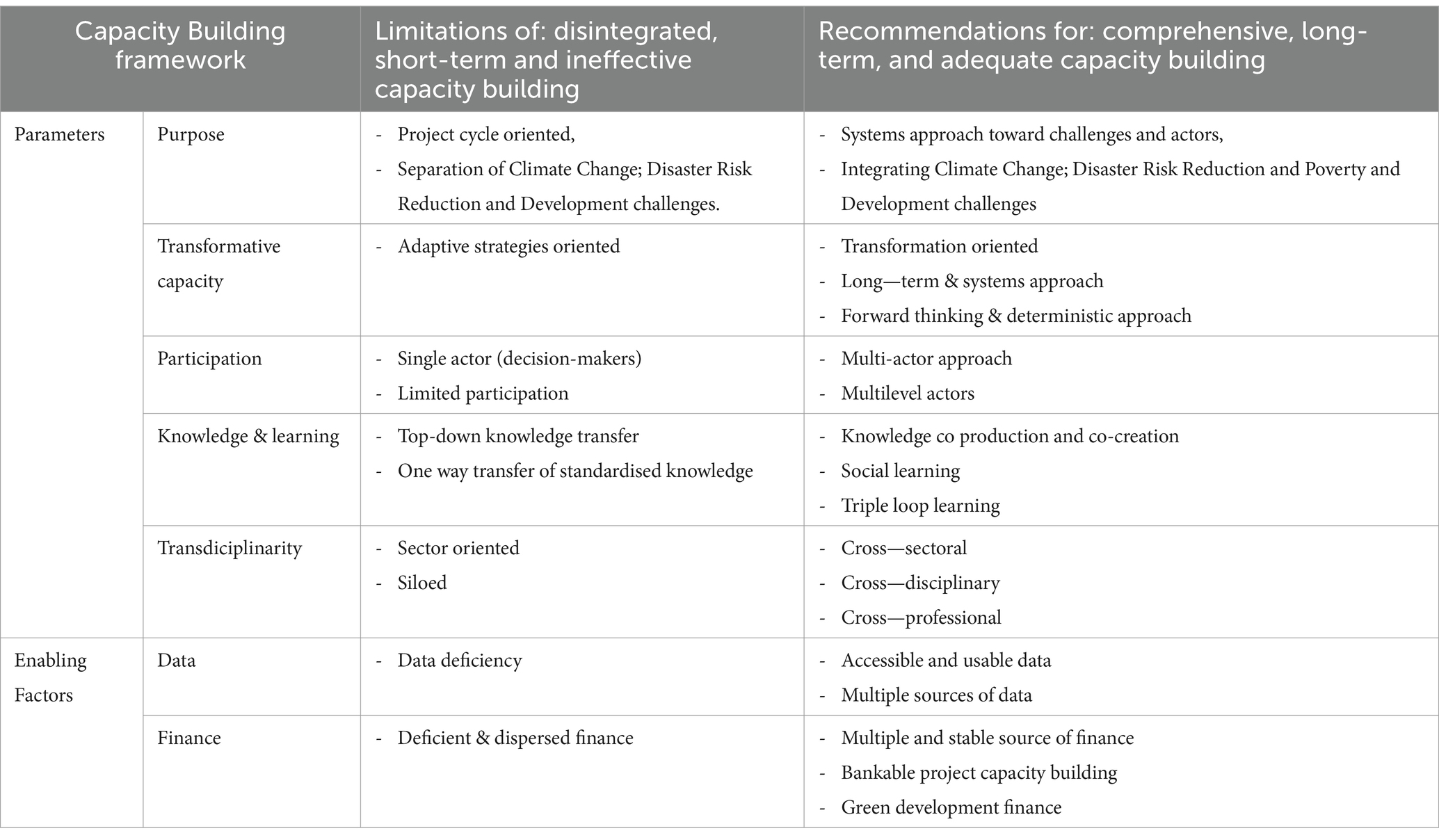
Table 5. Limitations of and recommendations for the Capacity Building Parameters and Enabling Factors (source: authors).
Gender integration in urban resilience capacity building is crucial, as highlighted in two reviewed articles (Jabeen, 2014; Hlahla et al., 2022), which underscore the necessity of enhancing women’s adaptive capacities in climate change response. It is essential that both men and women should be involved in decision-making process to foster gender-sensitive practices and policies. This inclusivity should extend to participatory processes and initiatives for monitoring, evaluation, and learning. Additionally, technology transfer, as outlined in the Paris Agreement, requires attention in capacity building literature.
We recognize the need for customized capacity building approaches tailored to each locality. This requires a thorough understanding of local contexts and needs through precise mapping of current capacities and specific needs, aware of the context. The evaluation process should incorporate Capacity Building Parameters and Enabling Factors to develop an advanced framework for building new capacities for planning, management and development of cities within high complexity and uncertainty context. However, the current framework is not exhaustive, thus further research is essential to enhance its comprehensiveness and transformative potential. Additional research could validate capacity building needs and gaps from a professional perspective. Moreover, regional-level research could be conducted to understand differences in terms of needs and research outputs, for example monitoring the regional funding landscape for capacity building in the framework of urban resilience.
Author contributions
KW: Conceptualization, Data curation, Formal analysis, Investigation, Methodology, Project administration, Visualization, Writing – original draft, Writing – review & editing. NT: Conceptualization, Writing – review & editing, Formal analysis, Methodology, Supervision. MS: Writing – review & editing, Conceptualization, Formal analysis, Supervision.
Funding
The author(s) declare that no financial support was received for the research, authorship, and/or publication of this article.
Conflict of interest
The authors declare that the research was conducted in the absence of any commercial or financial relationships that could be construed as a potential conflict of interest.
Publisher’s note
All claims expressed in this article are solely those of the authors and do not necessarily represent those of their affiliated organizations, or those of the publisher, the editors and the reviewers. Any product that may be evaluated in this article, or claim that may be made by its manufacturer, is not guaranteed or endorsed by the publisher.
References
Adekola, O., Lamond, J., Adelekan, I., and Eze, E. B. (2020). Evaluating flood adaptation governance in the city of Calabar, Nigeria. Clim. Dev. 12, 840–853. doi: 10.1080/17565529.2019.1700771
Albagli, S., and Iwama, A. Y. (2022). Citizen science and the right to research: building local knowledge of climate change impacts. Hum. Soc. Sci. Commun. 9:39. doi: 10.1057/s41599-022-01040-8
Archer, D., and Dodman, D. (2015). Making capacity building critical: power and justice in building urban climate resilience in Indonesia and Thailand. Urban Clim. 14, 68–78. doi: 10.1016/j.uclim.2015.06.007
Arnstein, S. R. (2019). A ladder of citizen participation. J. Am. Plan. Assoc. 85, 24–34. doi: 10.1080/01944363.2018.1559388
Ayers, J. (2009). International funding to support urban adaptation to climate change. Environ. Urban. 21, 225–240. doi: 10.1177/0956247809103021
Bigger, P., and Webber, S. (2021). Green structural adjustment in the World Bank's Resilient City. Ann. Am. Assoc. Geogr. 111, 36–51. doi: 10.1080/24694452.2020.1749023
Brown, A., Dayal, A., and Rumbaitis Del Rio, C. (2012). From practice to theory: emerging lessons from Asia for building urban climate change resilience. Environ. Urban. 24, 531–556. doi: 10.1177/0956247812456490
Brunetta, G., and Caldarice, O. (2018). Putting resilience into practice. The spatial planning response to urban risks. Urban resilience for risk and adaptation governance. Cham, Springer International Publishing: 27–41.
Bulkeley, H., and Castán Broto, V. (2013). Government by experiment? Global cities and the governing of climate change. Trans. Inst. British Geograph. (1965) 38, 361–375. doi: 10.1111/j.1475-5661.2012.00535.x
Caldarice, O., Brunetta, G., and Tollin, N. (2018). The challenge of urban resilience: operationalization. Urban Resilience for Risk and Adaptation Governance. Cham, Springer International Publishing: 1–6.
Colenbrander, S., Dodman, D., and Mitlin, D. (2018). Using climate finance to advance climate justice: the politics and practice of channelling resources to the local level. Clim. Pol. 18, 902–915. doi: 10.1080/14693062.2017.1388212
Collins, K., and Ison, R. (2009). Jumping off Arnstein's ladder: social learning as a new policy paradigm for climate change adaptation. Environ. Policy Gov. 19, 358–373. doi: 10.1002/eet.523
Davoudi, S., Shaw, K., Haider, L. J., Quinlan, A. E., Peterson, G. D., Wilkinson, C., et al. (2012). Resilience: a bridging concept or a dead end? "reframing" resilience: challenges for planning theory and practice interacting traps: resilience assessment of a pasture management system in northern Afghanistan urban resilience: what does it mean in planning practice? Resilience as a useful concept for climate change adaptation? The politics of resilience for planning: a cautionary note: edited by Simin Davoudi and Libby Porter. Plan. Theory Pract. 13, 299–333. doi: 10.1080/14649357.2012.677124
Einecker, R., and Kirby, A. (2020). Climate change: a bibliometric study of adaptation, mitigation and resilience. Sustainability 12:6935. doi: 10.3390/su12176935
Fatemi, M. N., Okyere, S. A., Diko, S. K., and Kita, M. (2020). Multi-level climate governance in Bangladesh via climate change mainstreaming: lessons for local climate action in Dhaka City. Urban Sci. 4:18. doi: 10.3390/urbansci4020024
Ferraz da Silva, P. I. (2022). Capacity building as the cornerstone of the climate change regime: evolution of the agenda through a policy-practitioner view from Brazil. Clim. Pol. 22, 687–694. doi: 10.1080/14693062.2022.2074351
Guo, P., Li, Q., Guo, H., Li, H., and Yang, L. (2022). A bibliometric and visual analysis of global urban resilience research in 2011–2020: development and hotspots. Sustain. For. 14:229. doi: 10.3390/su14010229
Gupta, J. (2016). Climate change governance: history, future, and triple-loop learning? Wiley interdisciplinary reviews. Clim. Change 7, 192–210. doi: 10.1002/wcc.388
Hagelsteen, M., and Becker, P. (2013). Challenging disparities in capacity development for disaster risk reduction. Int. J. Dis. Risk Reduct. 3, 4–13. doi: 10.1016/j.ijdrr.2012.11.001
Hagelsteen, M., and Becker, P. (2019). Systemic problems of capacity development for disaster risk reduction in a complex, uncertain, dynamic, and ambiguous world. Int. J. Dis. Risk Reduct. 36:10. doi: 10.1016/j.ijdrr.2019.101102
Hlahla, S., Simatele, M. D., Hill, T., and Mabhaudhi, T. (2022). Climate-urban Nexus: a study of vulnerable women in urban areas of KwaZulu-Natal Province, South Africa. Weather Clim. Soc. 14, 933–948. doi: 10.1175/WCAS-D-20-0180.1
Hossain, M. Z., and Rahman, M. A. U. (2018). Adaptation to climate change as resilience for urban extreme poor: lessons learned from targeted asset transfers programmes in Dhaka city of Bangladesh. Environ. Dev. Sustain. 20, 407–432. doi: 10.1007/s10668-016-9888-2
Hughes, S., Giest, S., and Tozer, L. (2020). Accountability and data-driven urban climate governance. Nat. Clim. Chang. 10, 1085–1090. doi: 10.1038/s41558-020-00953-z
IPCC (2023). Climate change 2022: impacts, adaptation and vulnerability working group II contribution to the sixth assessment report of the intergovernmental panel on climate change. Cambridge, Cambridge University Press.
Jabeen, H. (2014). Adapting the built environment: the role of gender in shaping vulnerability and resilience to climate extremes in Dhaka. Environ. Urban. 26, 147–165. doi: 10.1177/0956247813517851
Jabeen, H. (2015). Adapting the assets of urban low-income households with climate extremes: experience from Dhaka. Int. J. Urban Sustain. Dev. 7, 72–88. doi: 10.1080/19463138.2014.977293
Jahn, T., Bergmann, M., and Keil, F. (2012). Transdisciplinarity: between mainstreaming and marginalization. Ecol. Econ. 79, 1–10. doi: 10.1016/j.ecolecon.2012.04.017
Klinsky, S., and Sagar, A. D. (2022). The why, what and how of capacity building: some explorations. Clim. Pol. 22, 549–556. doi: 10.1080/14693062.2022.2065059
Laeni, N., van den Brink, M., Busscher, T., Ovink, H., and Arts, J. (2020). Building local institutional capacities for urban flood adaptation: lessons from the water as leverage program in Semarang, Indonesia. Sustain. For. 12:22. doi: 10.3390/su122310104
Levy, Y., and Ellis, T. J. (2006). A systems approach to conduct an effective literature review in support of information systems research. Inform. Sci. 9, 181–212. doi: 10.28945/479
Lwasa, S., Seto, K. C., Bai, X., Blanco, H., Gurney, K. R., Kilkiş, S., et al. (2022). “Urban systems and other settlements” in IPCC sixth assessment report. Working group III: Mitigation of climate change. eds. P. R. Shukla and J. Skea, R. Slade, A. Al Khourdajie, R. van Diemen, and D. McCollum, et al. (UK and New York, NY, USA: Cambridge University Press)
McEvoy, D., Iyer-Raniga, U., Ho, S., Mitchell, D., Jegatheesan, V., and Brown, N. (2019). Integrating teaching and learning with inter-disciplinary action research in support of climate resilient urban development. Sustainability (Basel, Switzerland) 11:6701. doi: 10.3390/su11236701
Meerow, S., Newell, J. P., and Stults, M. (2016). Defining urban resilience: a review. Landsc. Urban Plan. 147, 38–49. doi: 10.1016/j.landurbplan.2015.11.011
Moser, S. C., and Pike, C. (2015). Community engagement on adaptation: meeting a growing capacity need. Urban Clim. 14, 111–115. doi: 10.1016/j.uclim.2015.06.006
Nalau, J., and Verrall, B. (2021). Mapping the evolution and current trends in climate change adaptation science. Clim. Risk Manag. 32:100290. doi: 10.1016/j.crm.2021.100290
Nautiyal, S., and Klinsky, S. (2022). The knowledge politics of capacity building for climate change at the UNFCCC. Clim. Pol. 22, 576–592. doi: 10.1080/14693062.2022.2042176
Okoli, C. (2015). A guide to conducting a standalone systematic literature review. Commun. Assoc. Inf. Syst. 37:3743. doi: 10.17705/1CAIS.03743
Pillai, S., and Narayanan, N. C. (2022). Contextual knowledge co-production and capacity building for sanitation planning: experience from Kerala, India. Water Policy 24, 839–855. doi: 10.2166/wp.2021.094
Reed, S. O., Friend, R., Jarvie, J., Henceroth, J., Thinphanga, P., Singh, D., et al. (2015). Resilience projects as experiments: implementing climate change resilience in Asian cities. Clim. Dev. 7, 469–480. doi: 10.1080/17565529.2014.989190
Reed, S. O., Friend, R., Toan, V. C., Thinphanga, P., Sutarto, R., and Singh, D. (2013). "shared learning" for building urban climate resilience—experiences from Asian cities. Environ. Urban. 25, 393–412. doi: 10.1177/0956247813501136
Revi, A., Satterthwaite, D. E., Aragón-Durand, F., Corfee-Morlot, J., Kiunsi, M., Pelling, M., et al. (2014). “Urban areas. Climate change 2014: impacts, adaptation, and vulnerability. Part a: global and sectoral aspects” in Contribution of working group II to the fifth assessment report of the intergovernmental panel on climate change. eds. C. B. Field, V. R. Barros, and D. J. Dokken, et al. (Cambridge, United Kingdom and New York, NY, USA: Cambridge University Press), 535–612.
Roslan, A. F., Fernando, T., Biscaya, S., and Sulaiman, N. (2021). Transformation towards risk-sensitive urban development: a systematic review of the issues and challenges. Sustain. For. 13:24. doi: 10.3390/su131910631
Sharifi, A., Chelleri, L., Fox-Lent, C., Grafakos, S., Pathak, M., Olazabal, M., et al. (2017). Conceptualizing dimensions and characteristics of urban resilience: insights from a co-design process. Sustainability (Basel, Switzerland) 9:1032. doi: 10.3390/su9061032
Sharma, D., Singh, R., and Singh, R. (2014). Building urban climate resilience: learning from the ACCCRN experience in India. Int. J. Urban Sustain. Dev. 6, 133–153. doi: 10.1080/19463138.2014.937720
Shemdoe, R., Kassenga, G., and Mbuligwe, S. (2015). Implementing climate change adaptation and mitigation interventions at the local government levels in Tanzania: where do we start? Curr. Opin. Environ. Sustain. 13, 32–41. doi: 10.1016/j.cosust.2015.01.002
Solecki, W., Rosenzweig, C., Dhakal, S., Roberts, D., Barau, A. S., Schultz, S., et al. (2018). City transformations in a 1.5 degrees C warmer world. Nat. Clim. Chang. 8, 177–181. doi: 10.1038/s41558-018-0101-5
Spaliviero, M., de Dapper, M., Mannaerts, C. M., and Yachan, A. (2011). Participatory approach for integrated basin planning with focus on disaster risk reduction: the case of the Limpopo river. Water (Basel) 3, 737–763. doi: 10.3390/w3030737
Spaliviero, M., Pelling, M., Lopes, L. F., Tomaselli, C., Rochell, K., and Guambe, M. (2020). Resilience planning under information scarcity in fast growing African cities and towns: the CityRAP approach. Int. J. Dis. Risk Reduct. 44:101419. doi: 10.1016/j.ijdrr.2019.101419
Susskind, L., and Kim, A. (2022). Building local capacity to adapt to climate change. Clim. Pol., 22, 593–606. doi: 10.1080/14693062.2021.1874860
Tollin, N. (2017). "Sustainable and resilient cities: SDGs, new urban agenda and the Paris agreement." Energia, ambiente e innovazione 1/2017 15, 8–15. doi: 10.12910/EAI2017-001
Tollin, N., Hamhaber, J., Grafakos, S., Lwasa, S., and Morato, J. (2016). Sustainable urbanisation in the Paris Agreement: Comparative review of nationally determined contributions for urban content —Pre-release 2016. Nairobi, Kenya: United Nations Human Settlements Programme (UN-Habitat).
Tollin, N., Vener, J., Pizzorni, M., Saurí Gázquez, A., Gragnani, P., Manez, M., et al. (2022). “Urban climate action” in The urban content of the NDCs: global review 2022 (Nairobi), 67.
Tyler, S., Nugraha, E., Nguyen, H. K., Nguyen, N. V., Sari, A. D., Thinpanga, P., et al. (2016). Indicators of urban climate resilience: a contextual approach. Environ. Sci. Pol. 66, 420–426. doi: 10.1016/j.envsci.2016.08.004
UN (2018). World urbanisation prospects: the 2018 revision (ST/ESA/SER.A/420). United Nations, New York.
UNFCCC (2002). "The Marrakesh Accord & the Marrakesh Ministerial Declaration." United Nations Framework Convention on Climate Change (UNFCCC).
UNFCCC (2012). Summary report on the first meeting of the Durban forum. United Nations Framework Convention on Climate Change (UNFCCC).
UNFCCC (2016). Report of the conference of the parties on its twenty-first session, held in Paris from 30 November to 13 December 2015. Addendum. Part two: Action taken by the Conference of the Parties at its twenty-first session.
UNFCCC (2017). Report of the conference of the parties on its twenty-second session, held in Marrakech from 7 to 18 November 2016. Addendum. Part two: Action taken by the Conference of the Parties at its twentysecond session.
Wee, B. V., and Banister, D. (2016). How to write a literature review paper? Transp. Rev. 36, 278–288. doi: 10.1080/01441647.2015.1065456
Ziervogel, G. (2019). Building transformative capacity for adaptation planning and implementation that works for the urban poor: insights from South Africa. Ambio 48, 494–506. doi: 10.1007/s13280-018-1141-9
Ziervogel, G., Cowen, A., and Ziniades, J. (2016). Moving from adaptive to transformative capacity: building foundations for inclusive, thriving, and regenerative urban settlements. Sustain. For. 8:20. doi: 10.3390/su8090955
Keywords: capacity building, urban resilience, urban climate adaptation, Global South, climate change, literature review
Citation: Wieszczeczynska KA, Tollin N and Spaliviero M (2024) Capacity building within urban climate resilience in the Global South – a literature review. Front. Sustain. Cities. 6:1380936. doi: 10.3389/frsc.2024.1380936
Edited by:
Worradorn Phairuang, Kanazawa University, JapanReviewed by:
Parkpoom Choomanee, Kasetsart University, ThailandEmanuele Giorgi, Monterrey Institute of Technology and Higher Education, Mexico
Copyright © 2024 Wieszczeczynska, Tollin and Spaliviero. This is an open-access article distributed under the terms of the Creative Commons Attribution License (CC BY). The use, distribution or reproduction in other forums is permitted, provided the original author(s) and the copyright owner(s) are credited and that the original publication in this journal is cited, in accordance with accepted academic practice. No use, distribution or reproduction is permitted which does not comply with these terms.
*Correspondence: Katarzyna Alicja Wieszczeczynska, a2F3aUBpdGkuc2R1LmRr; ay53aWVzemN6ZWN6eW5za2FAZ21haWwuY29t
 Katarzyna Alicja Wieszczeczynska
Katarzyna Alicja Wieszczeczynska Nicola Tollin
Nicola Tollin Mathias Spaliviero2
Mathias Spaliviero2